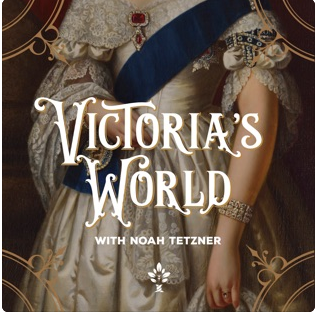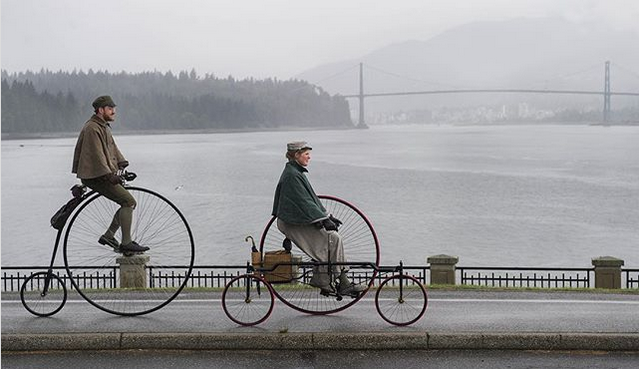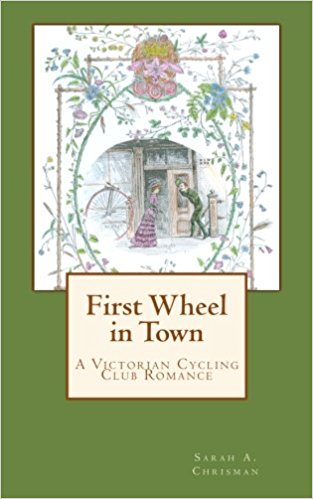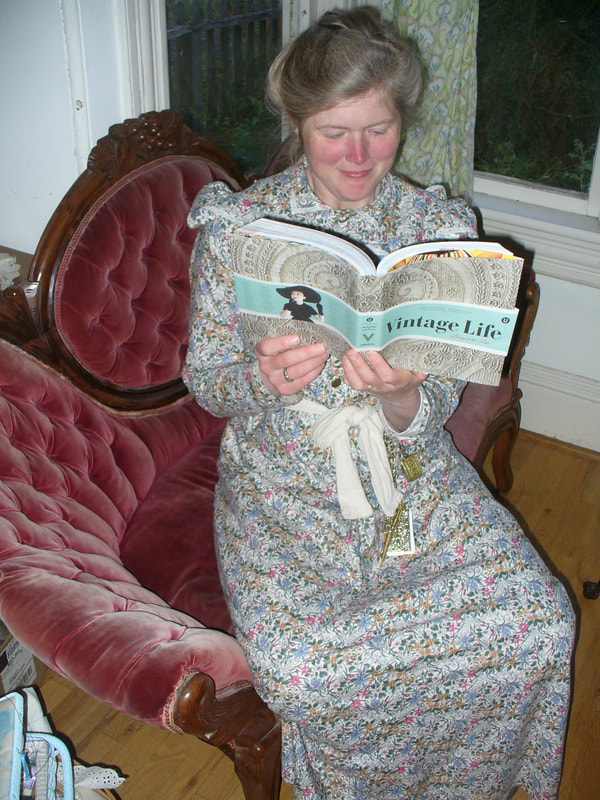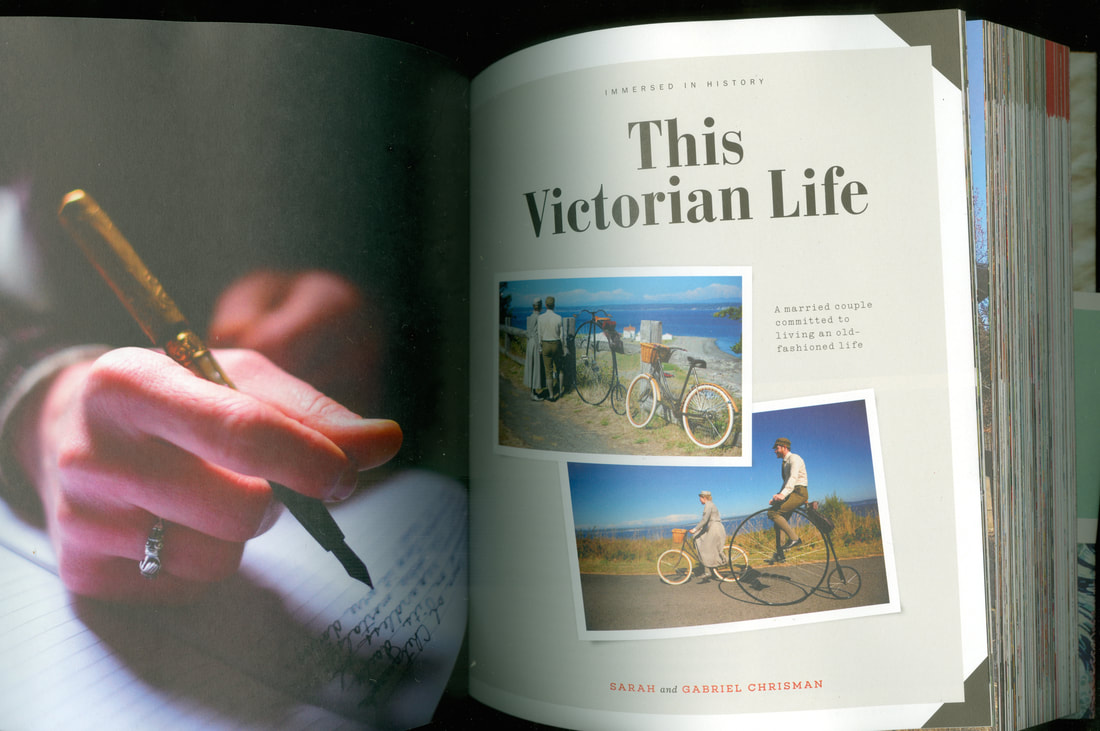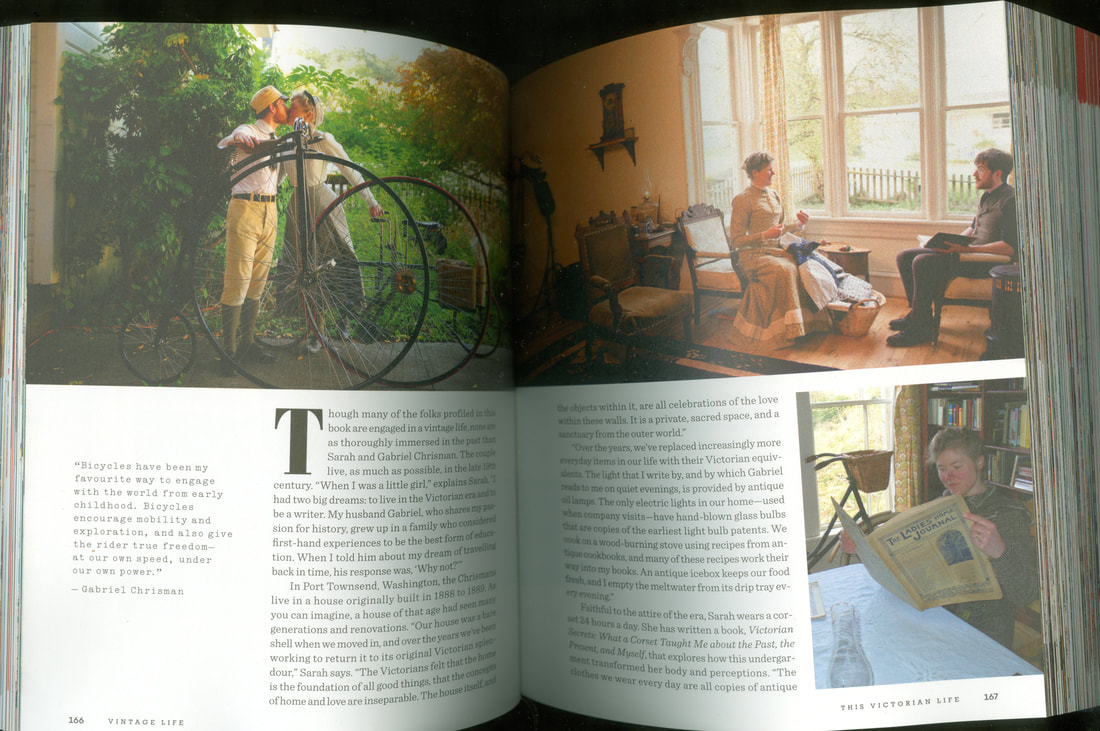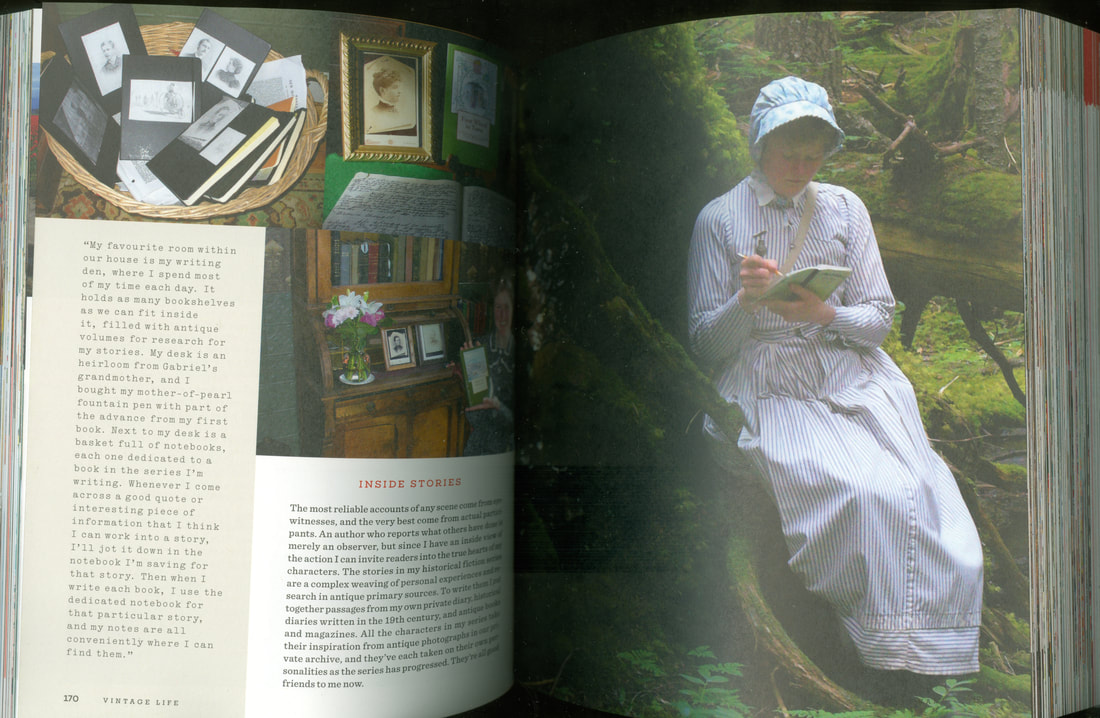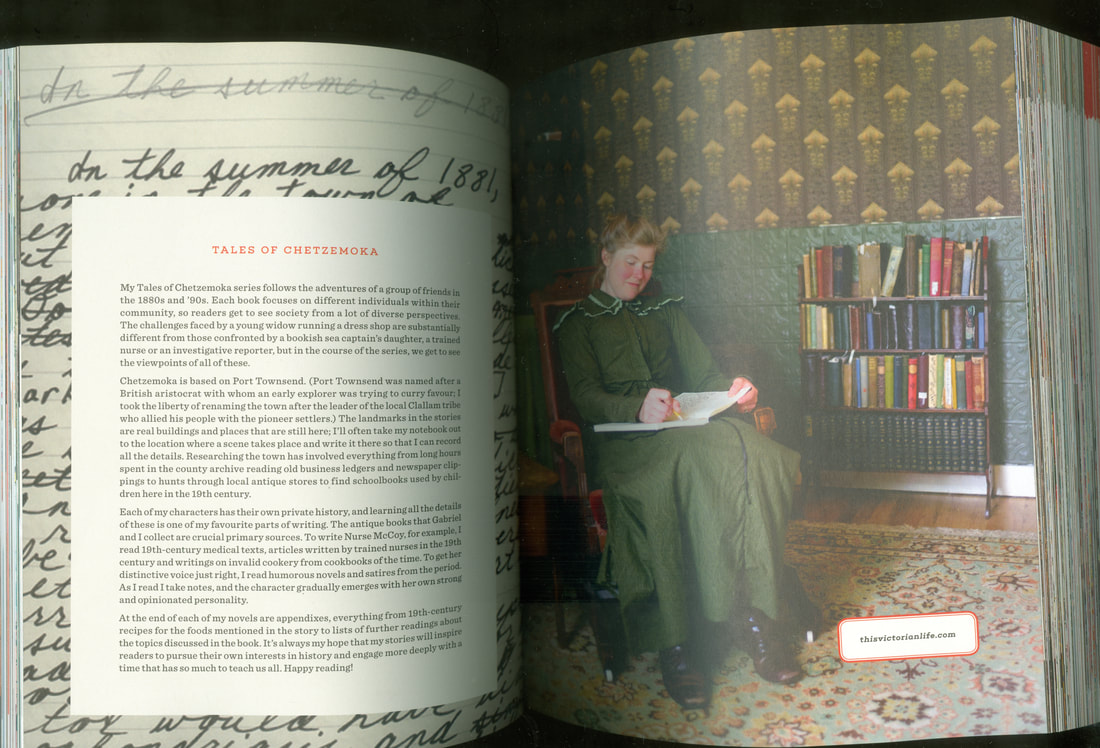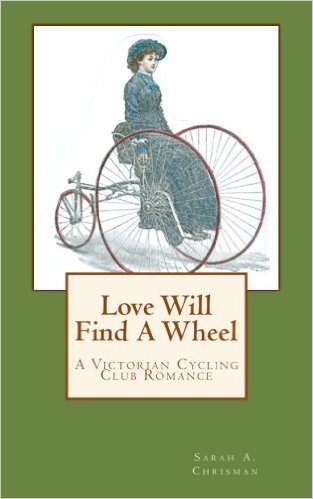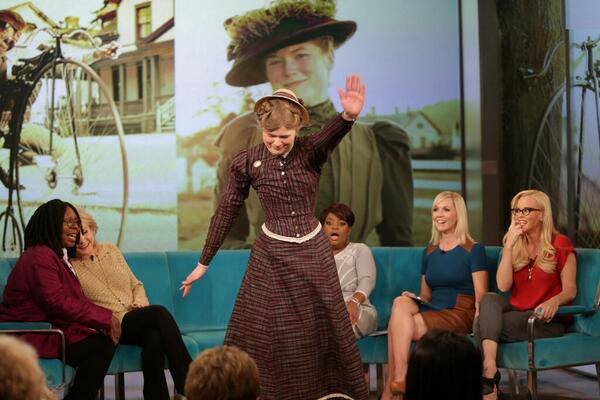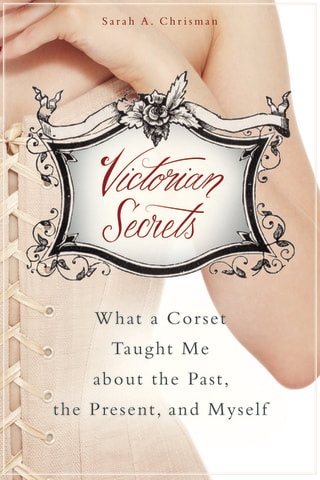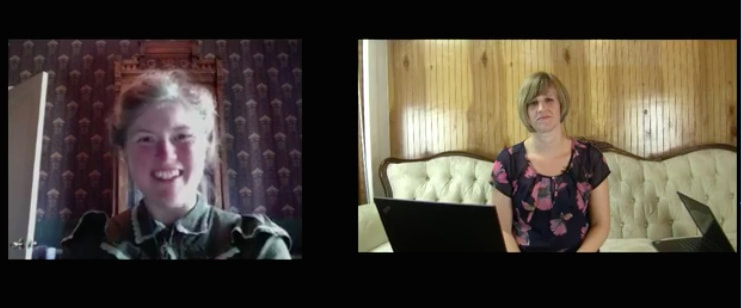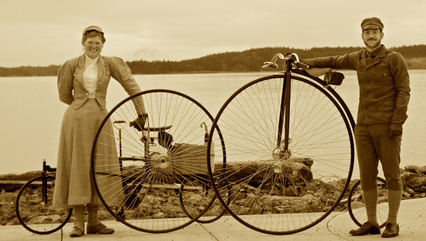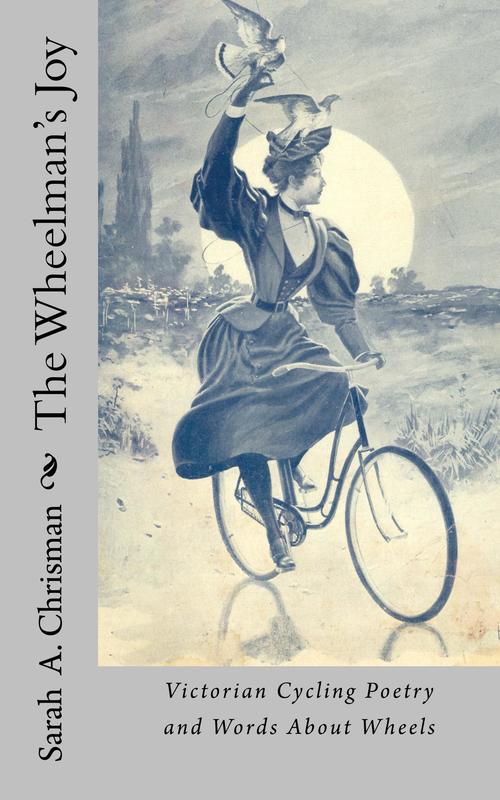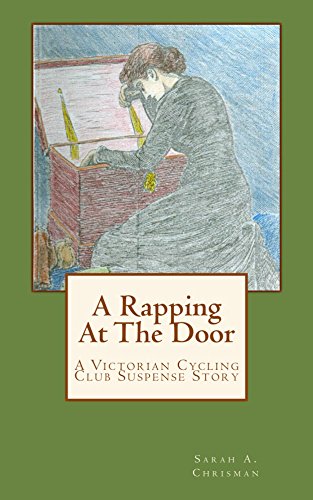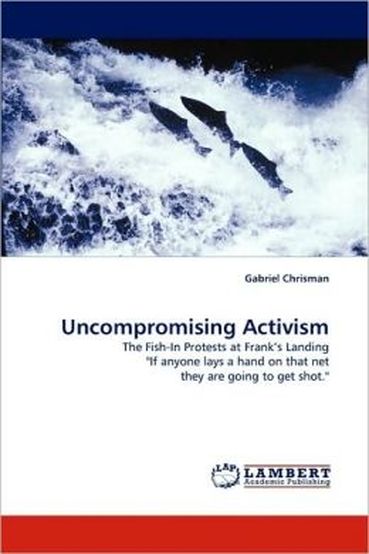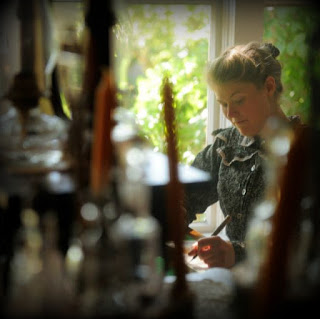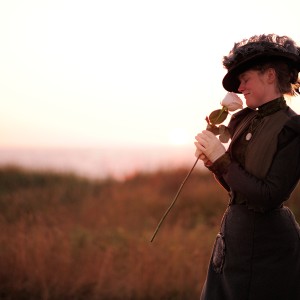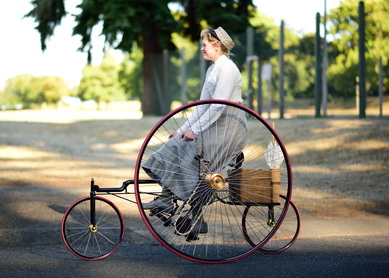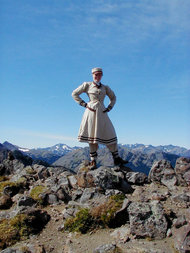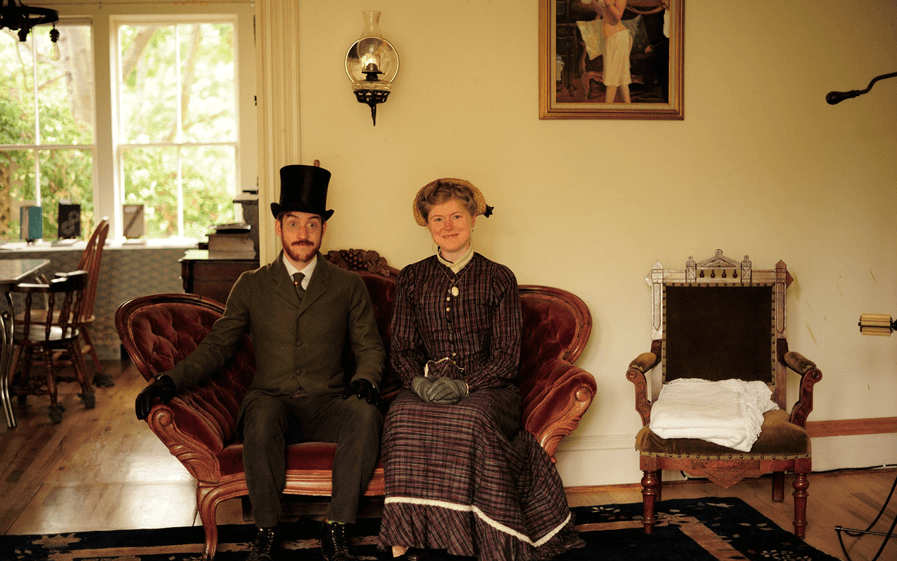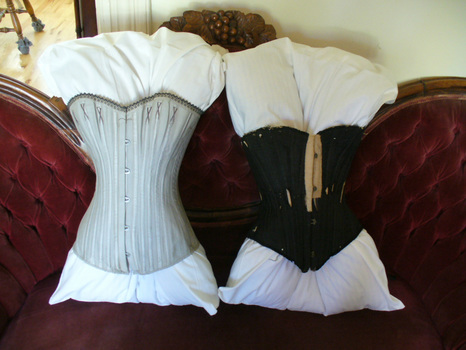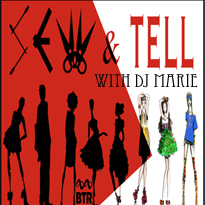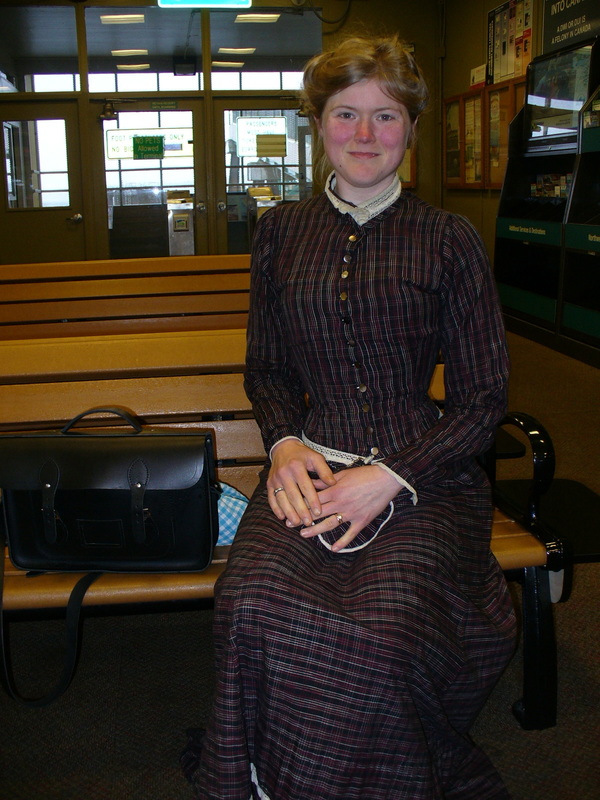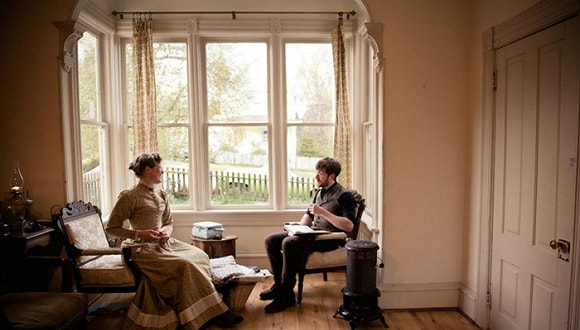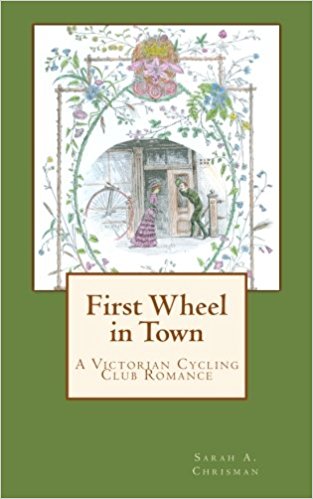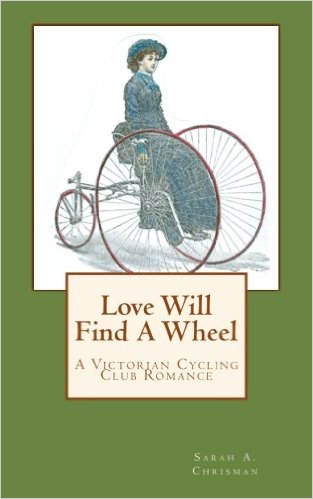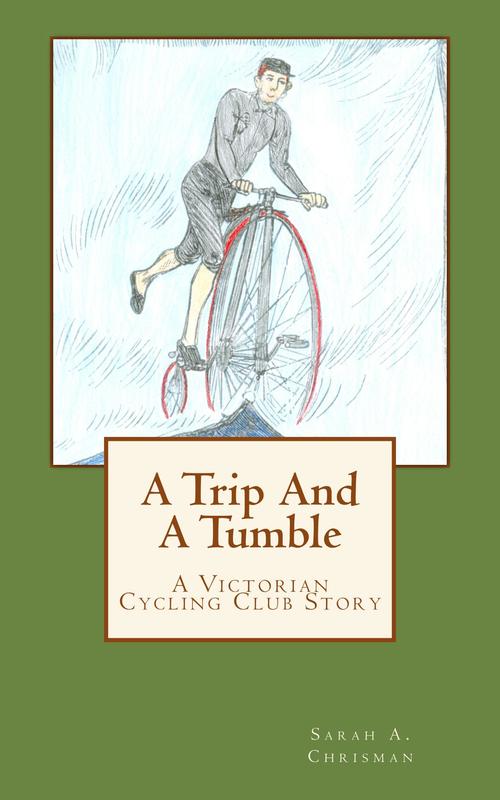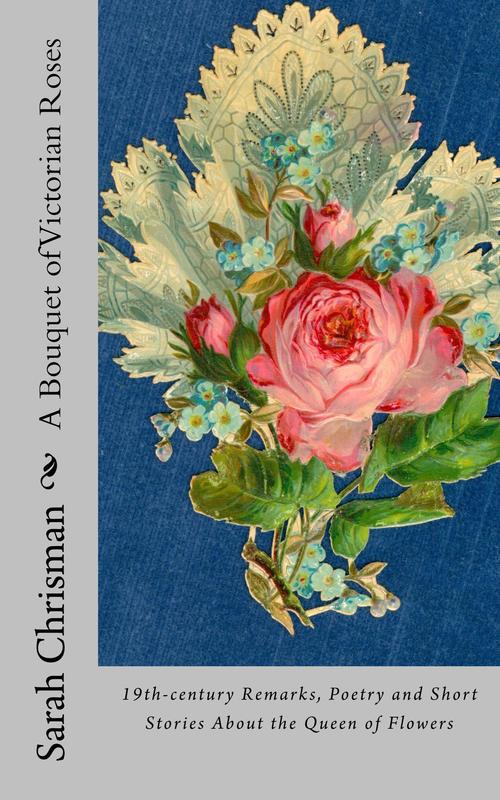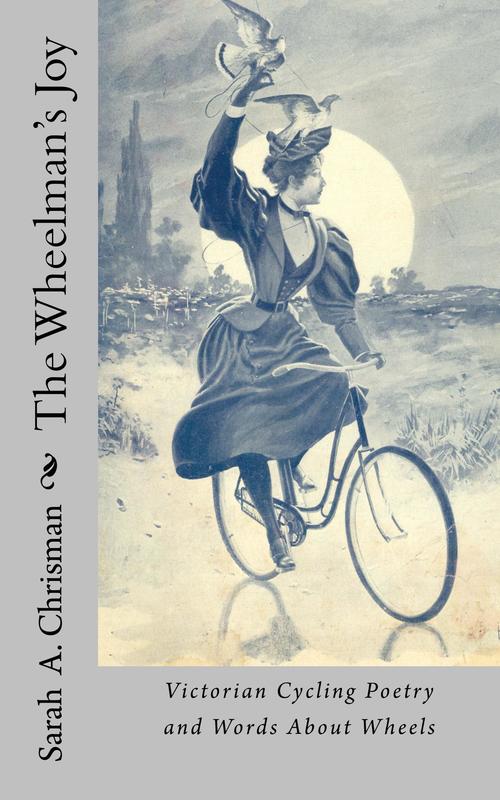Interviews
(Media representatives: Please see Press)
Interviews can be fun, but they don't actually support what we do in any tangible way. For that, we need people to buy Sarah's books!
Buying these books is the best way to show your support for what we do and help us keep doing it —thank you so much!
Past Interviews
and Media Appearances
The Edinburgh Book Review
In this time of instant and universal email traffic, built-in grammar checkers, desktop publishing and online writing courses, do we ever stop and think just how writers got by in the olden days? Without having Wikipedia at their beck and call, or being able to drag their laptop to any muse-inducing neck-of-the-woods, how did the authors of yore ever get around to writing their timeless classics? Well, you need wonder no more; Today, American author, dedicated Victorianist and modern-day lady of letters SARAH A. CHRISMAN lets us in on everything we ever wanted to know about her series of Victorian Cycling Club Romance novels and her unique way of writing…
Click here to read the full article!
Buy the book
https://podcasts.apple.com/us/podcast/everyday-life-in-the-victorian-age/id1491810901?i=1000461404648
Everyday Life in the Victorian Age (Sarah)
Victoria's World
Welcome to the debut episode of Victoria's World, a podcast about life and death in the age of Queen Victoria. Here in episode one, host Noah Tetzner chats with Sarah Chrisman about what everyday life was like during the age. Sarah Chrisman is author of This Victorian Life: Modern Adventures in Nineteenth-Century Culture, Cooking, Fashion, and Technology and several other popular books on the Victorian Era. If you like this episode, please be sure to rate and review it wherever you get podcasts.
Inventors & Inventions of Victorian England (Gabriel)
https://podcasts.apple.com/us/podcast/inventors-inventions-of-victorian-england/id1491810901?i=1000469254093
Join Noah Tetzner for a conversation with Gabriel Chrisman about the inventions and technology found in the ordinary homes of the middle-class Victorians. Gabriel is Co-founder of ThisVictorianLife.com and a renowned speaker on Victorian Era technology. Additionally, he is the creator of VictorianCycles.com, a business dedicated to reconstructing authentic Victorian bicycles. Remember to rate and review wherever you access podcasts!
Seattle Wrote
http://www.seattlewrote.com/2018/06/seattle-author-sarah-chrisman.html
"Although [Sarah] got her start in publishing nonfiction, historical fiction set in the Victorian Era is her passion… Set in the fictional town of Chetzemoka, which is named for a real local Native American chieftain, the location of the books is strongly inspired by the town of Port Townsend where Sarah and Gabriel live. The first book, First Wheel In Town: A Victorian Cycling Club Romance, takes place in the summer of 1881 when the local doctor introduces the first bicycle the town has ever seen. "I wanted to show the society from different perspectives, so each book focuses on different characters within the cycling club," Sarah said…"
Read the rest of the feature here.
Then read the books!
Urbo.com
https://www.urbo.com/content/what-its-like-in-nontraditional-living-situations/
(We're in the later part of this article —when you go to the site, scroll down to the heading, "Victorian Secrets".)
"…For some people, home is a place. For others, it’s an entire lifestyle.… Chrisman is a novelist, and the Victorian lifestyle helps inform her work. “One of the basic axioms of writing is ‘write what you know,’ and living with Victorian technologies and cultural elements on a daily basis helps me know and understand them at a very deep level,” she says. “When I mention the cat’s-whisker sense that tells a woman her skirts are brushing a piece of furniture or a character gripping her chatelaine chains together so she can move stealthily without them clanking or the way that the homey smell of kerosene can raise someone’s spirits when a lamp is lit on a gloomy night, these, and many more, are things I experience myself with quite some frequency.…"
Read the rest of the piece here.
First Wheel in Town
|
Vintage Life, Uppercase Encyclopedia of Inspiration, Volume V
"…When I was a little girl," explains Sarah, "I had two big dreams: to live in the Victorian era, and to be a writer. My husband Gabriel, who shares my passion for history, grew up in a family who considered first-hand experiences to be the best form of education. When I told him about my dream of traveling back in time, his response was, "Why not?"…"
Get your copy of Vintage life at https://www.uppercasemagazine.com/
Get your copy of Vintage life at https://www.uppercasemagazine.com/
"…In the nineteenth-century, there was a philosophy that we should have nothing in our homes which we do not know to be useful or feel to be beautiful —preferably both. Our surroundings have a subtle yet unavoidable influence on us, the way that water shapes stone, and we therefore have an obligation to ourselves to make sure that those surroundings forward goals to which we truly aspire." —Sarah A. Chrisman…"
Get your copy of Vintage life at https://www.uppercasemagazine.com/
Get your copy of Vintage life at https://www.uppercasemagazine.com/
"…The most reliable accounts of any scene come from eyewitnesses, and the very best come from actual participants. An author who reports what others have done is merely an observer, but since I have an inside view of the action I can invite readers into the true hearts of my characters. The stories in my historical fiction series are a complex weaving of personal experiences and research in antique primary sources. To write them I put together passages from my own private diary, historical diaries written in the nineteenth-century, and from antique books and magazines. The personal appearances of all the characters in my series take their inspiration from antique photographs in our private archive, and they've each taken on their own personalities as the series has progressed. They're all good friends to me by now.…"
Get your copy of Vintage life at https://www.uppercasemagazine.com/
Get your copy of Vintage life at https://www.uppercasemagazine.com/
"…My Tales of Chetzemoka series follows the adventures of a group of friends in the 1880's and '90's. Each book focuses on different individuals within their community, so readers get to see the society from a lot of diverse perspectives. The challenges faced by a young widow running a dress shop are substantially different from those confronted by a bookish sea-captain's daughter, a trained nurse, or an investigative reporter, but in the course of the series we get to see the viewpoints of all of these.
The town of Chetzemoka is based on Port Townsend, where we live. (Port Townsend was named after a British aristocrat with whom an early explorer was trying to curry favor; I took the liberty of renaming the town after the leader of the local Clallam tribe who allied his people with the pioneer settlers.) The landmarks in the stories are real buildings and places which are still here; I'll often take my notebook out to the location where a scene takes place and write it there so that I can record all the details. Researching the town has involved everything from long hours spent in the county archive reading old business ledgers and newspaper clippings, to hunts through local antique stores to find schoolbooks used by children here in the nineteenth-century.
Each of my characters has their own private history, and learning all the details of these is one of my favorite parts of writing. The antique books which Gabriel and I collect are crucial primary sources. To write Nurse McCoy, for example, I read nineteenth-century medical texts, articles written by trained nurses in the nineteenth-century, and writings on invalid cookery from cookbooks of the time. To get her distinctive voice just right, I read humorous novels and satires from the period. As I read I take notes, and the character gradually emerges with her own strong and opinionated personality.
I always prefer antique copies of books, when I can get them. The original sources that have traveled through time to get to us provide a very tangible connection to the past. The hand-written notes in their margins and other traces of their prior owners provide value beyond the words of the text itself. In cases where a particular book has become so rare that only a digital copy is available I'll print it out and bind it myself by hand so that I have a physical copy to use. There have been some really interesting studies into the way the brain interacts with physical books as opposed to screens, and there's a lot of evidence showing that the human mind engages more deeply with information obtained through a physical book.
At the end of each of my novels are appendixes, everything from nineteenth-century recipes for the foods mentioned in the story to lists of further readings about the topics discussed in the book. It's always my hope that my stories will inspire readers to pursue their own interests in history and engage more deeply with a time that has so much to teach us all. Happy reading!"
Get your copy of Vintage life at https://www.uppercasemagazine.com/
The town of Chetzemoka is based on Port Townsend, where we live. (Port Townsend was named after a British aristocrat with whom an early explorer was trying to curry favor; I took the liberty of renaming the town after the leader of the local Clallam tribe who allied his people with the pioneer settlers.) The landmarks in the stories are real buildings and places which are still here; I'll often take my notebook out to the location where a scene takes place and write it there so that I can record all the details. Researching the town has involved everything from long hours spent in the county archive reading old business ledgers and newspaper clippings, to hunts through local antique stores to find schoolbooks used by children here in the nineteenth-century.
Each of my characters has their own private history, and learning all the details of these is one of my favorite parts of writing. The antique books which Gabriel and I collect are crucial primary sources. To write Nurse McCoy, for example, I read nineteenth-century medical texts, articles written by trained nurses in the nineteenth-century, and writings on invalid cookery from cookbooks of the time. To get her distinctive voice just right, I read humorous novels and satires from the period. As I read I take notes, and the character gradually emerges with her own strong and opinionated personality.
I always prefer antique copies of books, when I can get them. The original sources that have traveled through time to get to us provide a very tangible connection to the past. The hand-written notes in their margins and other traces of their prior owners provide value beyond the words of the text itself. In cases where a particular book has become so rare that only a digital copy is available I'll print it out and bind it myself by hand so that I have a physical copy to use. There have been some really interesting studies into the way the brain interacts with physical books as opposed to screens, and there's a lot of evidence showing that the human mind engages more deeply with information obtained through a physical book.
At the end of each of my novels are appendixes, everything from nineteenth-century recipes for the foods mentioned in the story to lists of further readings about the topics discussed in the book. It's always my hope that my stories will inspire readers to pursue their own interests in history and engage more deeply with a time that has so much to teach us all. Happy reading!"
Get your copy of Vintage life at https://www.uppercasemagazine.com/
Society19
http://www.societynineteenjournal.com/2015/11/so19-talks-with-sarah-chrisman.html
"Many people, including myself, are fascinated by the 19th century, but very few of us actually live it. Sarah and Gabriel Chrisman are exceptions to that norm, choosing to live as Victorian an existence as can be managed within the framework of today’s goods and infrastructure. As described in Sarah’s book This Victorian Life (Skyhorse, November 2015), the result of this decision has been a journey both practical and spiritual, challenging and joyous…"
Read the rest of the piece here
Love Will Find A Wheel
|
The View
In the first week of December, 2013 Sarah was invited to appear on episode 64 of Whoopi Goldberg's program, "The View" in New York City, and to discuss her book Victorian Secrets: What A Corset Taught Me About the Past, the Present, and Myself. When Barbara Walters expressed doubts as to her flexibility, she demonstrated toe-touches and jumping jacks!
"Talk about kickin' it old-school!" —Whoopi Goldberg
|
The New York Post's "Extraordinary People":
https://www.facebook.com/ExtraordinaryPeople/videos/392135884885941/?epa=SEARCH_BOX
"…When I'm writing about things I do every day, it gives them a very firm reality…"
Interview with Roseanna White:
https://www.facebook.com/RoseannaMWhite/videos/515357138872651/?notif_id=1537791954883875¬if_t=live_video_schedule_broadcaster
Delivery Delayed
|
"How To Bike Like A Victorian"
in Bicycling Magazine:
http://www.bicycling.com/culture/people/old-doesn-t-mean-bad-modern-conversation-victorian-era-cyclists
"Interviewing the couple feels like a history lesson about cycling in the 1880s…"
|
Nightline
http://abcnews.go.com/Lifestyle/meet-washington-couple-lives-victorian-era/story?id=34920909
A Rapping At The Door
|
"Sacred Catch" Radio Interview with Gabriel
http://kuow.org/post/schelangen-also-right#.UuAbBIpYigE.facebook
(Click on the link above to hear Gabriel talking to a local journalist about the historic significance of fishing rights.)
On Seattle Curbed
by Sean Keeley
https://seattle.curbed.com/2015/10/27/9906670/victorian-couple-seattle-port-townsend
"Laying across Sarah and Gabriel Chrisman's living room is a big swath of blue carpet. The carpet belong to Gabriel's grandmother as well as Gabriel's grandmother's cat, which spent twenty years scratching a threadbare patch right near the middle. A collector might look at this damaged rug and deem it worthless. To the Chrisman's, however, it's an invaluable family heirloom. It's story is what gives it value.
You probably know Sarah and Gabriel as "The Victorian Couple," the married couple who live in Port Townsend, WA and have dedicated their lives to studying and living amongst the culture and technologies of the late nineteenth-century. There's a good chance that you've already got a preconceived notion about who they are and how they live, but until you've stepped inside their 1888-built Victorian home and heard their reasons, you might not really understand what they're about…"
Read the rest of the article
***
The Morning Show
(Australia)
***
Our story on Hello Giggles
by Carina Sitkus
http://hellogiggles.com/couple-living-victorian/#read
***
In Good Housekeeping
http://www.goodhousekeeping.com/life/a35331/couple-lives-like-victorian-era/
***
On KIRO Radio
By Rachel Belle:
http://mynorthwest.com/874/2811725/A-Victorian-era-obsessed-Port-Townsend-couple-lives-as-if-its-the-1880s
On Late Night Library Conversation:
http://latenightlibrary.org/sarah-chrisman-this-victorian-life/_
***
In the Shoshone News Press
By Josh McDonald
In the Vancouver Sun
http://vancouversun.com/news/local-news/couple-cycles-around-seawall-in-19th-century-style-bicycle-and-tricycle
***
Victoria's Butchart Gardens kicks out couple wearing Victorian-era style
http://goldpointe.newsvine.com/_news/2016/08/17/35963821-victorias-butchart-gardens-kicks-out-couple-wearing-victorian-era-style
***
On HLN
by Colette Bennett
http://www.hlntv.com/slideshow/2015/09/10/victorian-era-couple-gallery
***
On Modes de Vie (French)
http://modesdevie.com/passionnee-epoque-victorienne-jai-decide-dy-vivre/_
***
***
The New York Times
The Return of the Tight Squeeze
By LAREN STOVER
Published: November 22, 2013
When Sarah A. Chrisman received a blue silk rose-patterned corset from her husband, a librarian and bicycle-shop manager, for her 29th birthday, she reluctantly allowed him to lace her into it. She believed then, she said recently, that corsets “deformed, broke bones, tortured and killed.”
But Ms. Chrisman, 33, a massage therapist and Victoriana enthusiast, quickly grew fond of her new undergarment. With constant wear — even sleeping in it — she said that her posture improved, that she ate less and that she transformed not only her wardrobe (from frumpy tees to fitted blouses), but also her waist size, from 32 to 22 inches.
This being the “Fifty Shades of Grey” era, it is no surprise that she then decided to write a book about the experience. But nothing about “Victorian Secrets: What a Corset Taught Me About the Past, the Present, and Myself” (Skyhorse Publishing) is racy. The most suggestive phrase the author uses to describe her newfound silhouette is “showed off my figure to full advantage.”
To describe that figure, “I would say ‘womanly’, and that can certainly be sexy,” said Ms. Chrisman, who lives in Port Townsend, Wash., reads 19th-century etiquette manuals, writes snail mail with antique dip pens and has thus far managed to avoid Twitter. “The corset emphasizes the difference between the genders, which I really like. My natural inclination to avoid that term ‘sexy’ per se probably comes out of my training as a massage practitioner, where everything has to be very distinctly delineated. That is, the sex stays out of it.”
While clients are respectful of her boundaries, Ms. Chrisman said, she has found herself frequently ogled, questioned and even groped by strangers.
The most popular question: Does it hurt? Her answer: “It’s like a hug that lasts all day.” Rudest question: Do you take that thing off before you have sex? Ms. Chrisman refuses to respond to that one.
She is not alone among moderns in her revival of what Valerie Steele, the director and chief curator of the Museum at the Fashion Institute of Technology, called “probably the most controversial garment in the entire history of fashion” in her book “The Corset: A Cultural History” (Yale University Press, 2001).
“Plenty of designers occasionally put a corset in their collections, but I’d say 99 percent of people choose Spanx as an undergarment,” said Dr. Steele, who credits the punks and Vivienne Westwood in the 1970s for giving the corset “the charisma of deviance” and Jean-Paul Gaultier in the ’80s (Madonna wore his corset onstage) for “making underwear as outerwear significant.”
Dr. Steele said that designers tend to interpret corsets in two ways: either they’re “fierce, dominatrix, S & M-inspired” or “romantic, glamorous and belle epoch.” Only the hourglass shape remains constant. “A small waist is a signifier of nubile femininity and fertility,” Dr. Steele said.
Alexis Lass, a former dominatrix in New York who wrote about her experiences in “The Posh Girl’s Guide to Play” (Seal Press, 2013), has a collection of more than 50 corsets. “Feminists have protested that the cinching of the waist is an ugly example of suffering for ‘beauty,’ but I find waist cinching to be physically and emotionally empowering,” Ms. Lass said, though she has her limits: “I’ve yet to go to Starbucks in my Marie Antoinette corset.”
Whether medically sound or not (opinions are mixed, and Ms. Chrisman seeks to debunk the taboos), celebrities, including Jessica Alba and Kourtney Kardashian, have worn corsetlike garments after pregnancy to help recover their figures. Scarlett Johansson wears a white corset on the cover of the December issue of Vogue México. And Dita von Teese, the burlesque star, appears in a scarlet corset and little else on her business card.
Ms. von Teese wrote in an email: “People ask if it’s comfortable, and I try to explain that it’s like wearing a very high heel. There is discipline involved, and of course, the quality of the construction is paramount to comfort.” Her collection includes examples from the revered corsetmaker Mr. Pearl, who has collaborated with Mr. Gaultier and Alexander McQueen.
Cindy Sibilsky, the producer of a musical based on Xaviera Hollander’s memoir “The Happy Hooker,” likes to throw a suit jacket over a corset. “The modern-day woman wears a corset on the outside as a symbol of her sexual liberation, power and prowess rather than the traditional idea of the corset as a tool of repression and restriction,” she said.
But Ms. Chrisman believes that corsets should remain tucked away. “I think that the fact that some people are wearing corsets as outerwear is a very good example of how little privacy there is in modern life,” she said. “People actively invade their own privacy.” Though she conceded: “I will say one thing about the people who wear corsets as outerwear: it does show off the beauty of the garment itself. They are beautiful pieces of art.”
Indeed, Mr. Pearl’s creations have prices starting at $10,000, Ms. von Teese wrote. Though Ms. Chrisman said she dreams of owning a Pearl model, her corsets (she now owns a half-dozen) are put through more-quotidian paces. They have set off metal detectors at airports, she said, and ascended Mount Townsend and Hurricane Ridge in Washington state.
She emphasized, again, that the corset to her is “strictly underwear” and that she sees herself as “a lady and not a vixen.”
Not that there would be anything wrong with that, of course. “The vibrator was invented in the Victorian era,” Ms. Chrisman said. “People forget that.”
A version of this article appears in print on November 24, 2013, on page ST12 of the National edition with the headline: The Return of the Tight Squeeze.
By LAREN STOVER
Published: November 22, 2013
When Sarah A. Chrisman received a blue silk rose-patterned corset from her husband, a librarian and bicycle-shop manager, for her 29th birthday, she reluctantly allowed him to lace her into it. She believed then, she said recently, that corsets “deformed, broke bones, tortured and killed.”
But Ms. Chrisman, 33, a massage therapist and Victoriana enthusiast, quickly grew fond of her new undergarment. With constant wear — even sleeping in it — she said that her posture improved, that she ate less and that she transformed not only her wardrobe (from frumpy tees to fitted blouses), but also her waist size, from 32 to 22 inches.
This being the “Fifty Shades of Grey” era, it is no surprise that she then decided to write a book about the experience. But nothing about “Victorian Secrets: What a Corset Taught Me About the Past, the Present, and Myself” (Skyhorse Publishing) is racy. The most suggestive phrase the author uses to describe her newfound silhouette is “showed off my figure to full advantage.”
To describe that figure, “I would say ‘womanly’, and that can certainly be sexy,” said Ms. Chrisman, who lives in Port Townsend, Wash., reads 19th-century etiquette manuals, writes snail mail with antique dip pens and has thus far managed to avoid Twitter. “The corset emphasizes the difference between the genders, which I really like. My natural inclination to avoid that term ‘sexy’ per se probably comes out of my training as a massage practitioner, where everything has to be very distinctly delineated. That is, the sex stays out of it.”
While clients are respectful of her boundaries, Ms. Chrisman said, she has found herself frequently ogled, questioned and even groped by strangers.
The most popular question: Does it hurt? Her answer: “It’s like a hug that lasts all day.” Rudest question: Do you take that thing off before you have sex? Ms. Chrisman refuses to respond to that one.
She is not alone among moderns in her revival of what Valerie Steele, the director and chief curator of the Museum at the Fashion Institute of Technology, called “probably the most controversial garment in the entire history of fashion” in her book “The Corset: A Cultural History” (Yale University Press, 2001).
“Plenty of designers occasionally put a corset in their collections, but I’d say 99 percent of people choose Spanx as an undergarment,” said Dr. Steele, who credits the punks and Vivienne Westwood in the 1970s for giving the corset “the charisma of deviance” and Jean-Paul Gaultier in the ’80s (Madonna wore his corset onstage) for “making underwear as outerwear significant.”
Dr. Steele said that designers tend to interpret corsets in two ways: either they’re “fierce, dominatrix, S & M-inspired” or “romantic, glamorous and belle epoch.” Only the hourglass shape remains constant. “A small waist is a signifier of nubile femininity and fertility,” Dr. Steele said.
Alexis Lass, a former dominatrix in New York who wrote about her experiences in “The Posh Girl’s Guide to Play” (Seal Press, 2013), has a collection of more than 50 corsets. “Feminists have protested that the cinching of the waist is an ugly example of suffering for ‘beauty,’ but I find waist cinching to be physically and emotionally empowering,” Ms. Lass said, though she has her limits: “I’ve yet to go to Starbucks in my Marie Antoinette corset.”
Whether medically sound or not (opinions are mixed, and Ms. Chrisman seeks to debunk the taboos), celebrities, including Jessica Alba and Kourtney Kardashian, have worn corsetlike garments after pregnancy to help recover their figures. Scarlett Johansson wears a white corset on the cover of the December issue of Vogue México. And Dita von Teese, the burlesque star, appears in a scarlet corset and little else on her business card.
Ms. von Teese wrote in an email: “People ask if it’s comfortable, and I try to explain that it’s like wearing a very high heel. There is discipline involved, and of course, the quality of the construction is paramount to comfort.” Her collection includes examples from the revered corsetmaker Mr. Pearl, who has collaborated with Mr. Gaultier and Alexander McQueen.
Cindy Sibilsky, the producer of a musical based on Xaviera Hollander’s memoir “The Happy Hooker,” likes to throw a suit jacket over a corset. “The modern-day woman wears a corset on the outside as a symbol of her sexual liberation, power and prowess rather than the traditional idea of the corset as a tool of repression and restriction,” she said.
But Ms. Chrisman believes that corsets should remain tucked away. “I think that the fact that some people are wearing corsets as outerwear is a very good example of how little privacy there is in modern life,” she said. “People actively invade their own privacy.” Though she conceded: “I will say one thing about the people who wear corsets as outerwear: it does show off the beauty of the garment itself. They are beautiful pieces of art.”
Indeed, Mr. Pearl’s creations have prices starting at $10,000, Ms. von Teese wrote. Though Ms. Chrisman said she dreams of owning a Pearl model, her corsets (she now owns a half-dozen) are put through more-quotidian paces. They have set off metal detectors at airports, she said, and ascended Mount Townsend and Hurricane Ridge in Washington state.
She emphasized, again, that the corset to her is “strictly underwear” and that she sees herself as “a lady and not a vixen.”
Not that there would be anything wrong with that, of course. “The vibrator was invented in the Victorian era,” Ms. Chrisman said. “People forget that.”
A version of this article appears in print on November 24, 2013, on page ST12 of the National edition with the headline: The Return of the Tight Squeeze.
***
The New York Times
http://www.nytimes.com/2013/08/02/arts/design/for-fans-of-sendak-the-artist-keeps-giving.html?pagewanted=all&_r=1&
Article by EVE M. KAHN
Published: August 1, 2013
CELEBRATING A TIGHT FIT
Antique corsets survive in surprising numbers, and scholars, curators and collectors are scrutinizing them.
Exhibitions at the Musée des Arts Décoratifs in Paris and the Los Angeles County Museum of Art have surveyed the topic, and the Victoria and Albert Museum in London has organized a traveling show, “Undressed: 350 Years of Underwear in Fashion.” In Manhattan, vintage corsetry has gone on view with bloomers and stockings in bedrooms at the Morris-Jumel Mansion and the Merchant’s House Museum.
Auction prices for the torso-constricting pieces, especially for those in bright colors, have reached the high four figures.
“People are fascinated by body shaping, by what goes on under the garment,” said Karen Augusta, a couture historian and auction house owner. She will be bringing corsets and attachable skirt bustle contraptions to a November sale at her business, Augusta Auctions, in Manhattan. She added, “A lot of it is considered erotic, which brings out the crowds.”...
“I loved the soft feeling of being hugged all day,” Sarah A. Chrisman, a writer and massage therapist in Port Townsend, Wash., writes in a book due out this fall, “Victorian Secrets: What a Corset Taught Me about the Past, the Present, and Myself” (Skyhorse Publishing).
The corset has long been unfairly maligned, Ms. Chrisman said in a phone interview. Dr. John Harvey Kellogg, a 19th-century cereal magnate and health proselytizer, set off a widespread anti-corset movement by describing the garments as a “barbarous practice” that caused “painful menstrual derangements.” But he was not quite a reliable denouncer, Ms. Chrisman said, given his other extreme views: he was married but largely celibate, and he called masturbation “a crime doubly abominable.”
She credits corsets for improving women’s posture, diet and self-image. “It’s like a good supportive pair of shoes,” she said.
Article by EVE M. KAHN
Published: August 1, 2013
CELEBRATING A TIGHT FIT
Antique corsets survive in surprising numbers, and scholars, curators and collectors are scrutinizing them.
Exhibitions at the Musée des Arts Décoratifs in Paris and the Los Angeles County Museum of Art have surveyed the topic, and the Victoria and Albert Museum in London has organized a traveling show, “Undressed: 350 Years of Underwear in Fashion.” In Manhattan, vintage corsetry has gone on view with bloomers and stockings in bedrooms at the Morris-Jumel Mansion and the Merchant’s House Museum.
Auction prices for the torso-constricting pieces, especially for those in bright colors, have reached the high four figures.
“People are fascinated by body shaping, by what goes on under the garment,” said Karen Augusta, a couture historian and auction house owner. She will be bringing corsets and attachable skirt bustle contraptions to a November sale at her business, Augusta Auctions, in Manhattan. She added, “A lot of it is considered erotic, which brings out the crowds.”...
“I loved the soft feeling of being hugged all day,” Sarah A. Chrisman, a writer and massage therapist in Port Townsend, Wash., writes in a book due out this fall, “Victorian Secrets: What a Corset Taught Me about the Past, the Present, and Myself” (Skyhorse Publishing).
The corset has long been unfairly maligned, Ms. Chrisman said in a phone interview. Dr. John Harvey Kellogg, a 19th-century cereal magnate and health proselytizer, set off a widespread anti-corset movement by describing the garments as a “barbarous practice” that caused “painful menstrual derangements.” But he was not quite a reliable denouncer, Ms. Chrisman said, given his other extreme views: he was married but largely celibate, and he called masturbation “a crime doubly abominable.”
She credits corsets for improving women’s posture, diet and self-image. “It’s like a good supportive pair of shoes,” she said.
***
Guff.com
http://guff.com/these-people-decided-to-live-like-its-the-1800s-they-do-what
***
Today
http://www.today.com/news/time-warp-woman-lives-victorian-corset-all-2D11599299
Time warp: Woman lives as a Victorian, corset and all
Meena Hart Duerson
Nov. 15, 2013 at 9:08 AM ET
Sarah Chrisman never wanted to wear a corset, but after her husband gave her one for her 29th birthday, she says the old-fashioned undergarment changed her life.
"It was actually a moment of great revelation," the history lover, now 33, told TODAY.com of the experience, which allowed her to finally take advantage of her longtime obsession with Victorian-era attire.
She was inspired by the corset to delve deeper into wearing women's fashions from the Victorian age, and began to dress that way exclusively.
These days, she and her husband, Gabriel, are committed to living as Victorian a life as possible, within modern-day constraints. "We're as immersed as we can be," Chrisman said.
That means she washes herself "with a pitcher and basin every day," hand-sews all of her own clothes (from natural fibers), doesn't drive a car, and uses oil lamps for most of the lighting in their Victorian home in Port Townsend, Wash. When it comes to cooking, Chrisman uses a book of 19th century recipes, and said translating the centuries-old descriptions into modern-day measurements has proved the biggest challenge.
"It's involved a lot of experimentation to see what works and what doesn't," she said.
In Chrisman's book, she explains her motivation for living old-school.
The couple had always been fascinated by historical clothing and collected it, but while he could wear the vintage items, she couldn't find anything to fit her 21st-century body — all the clothes were tailored to a woman cinched in by a corset.
So, after years of resisting the shapewear over concerns it was unhealthy and uncomfortable, Chrisman was thrilled to find that putting it on wasn't nearly as bad as she'd imagined. "It was tough at first, but it just took some getting used to," she recalled.
Chrisman says they channel the Victorian era as a way of better understanding history. "The clothing is a really interesting window into everyday people's lives," she said. "It's a different way of looking at the world, and that was their world."
Ironically, she sometimes has to turn to modern technology to be transported to the past. Finding historically accurate light bulb replicas of what people would have used at that time, for example, entails shopping online.
"In the 19th century, it would have been very easy — we could have ordered it all from Sears and Roebuck," she laughs. "The 21st century Sears and Roebuck is the Internet."
In a book released Nov. 1, titled "Victorian Secrets: What a Corset Taught Me About the Past, the Present, and Myself," Chrisman offers insight, and explains her choice.
She says she was inspired to write the book after constant questioning about her appearance. "The reactions we get run the full gamut...everything from people who are wonderfully complimentary and kind to the ones that are incredibly vitriolic," she said.
"We've had everything from people stopping me to tell me I'm beautiful, or people stopping me to scream at me that I'm oppressing women. I never expected my underwear to be such a polarizing issue for complete strangers."
But despite the criticism, she says the experience has been incredibly positive, and she hopes other people who hear her story can apply some of the lessons she's learned to their own lives: "It's important to follow one's own interests and one's own dreams, and one should never let strangers dictate one's life," she says.
And for those who think it's just a gimmick, Chrisman says living this way is no experiment: "It's just our life."
Meena Hart Duerson
Nov. 15, 2013 at 9:08 AM ET
Sarah Chrisman never wanted to wear a corset, but after her husband gave her one for her 29th birthday, she says the old-fashioned undergarment changed her life.
"It was actually a moment of great revelation," the history lover, now 33, told TODAY.com of the experience, which allowed her to finally take advantage of her longtime obsession with Victorian-era attire.
She was inspired by the corset to delve deeper into wearing women's fashions from the Victorian age, and began to dress that way exclusively.
These days, she and her husband, Gabriel, are committed to living as Victorian a life as possible, within modern-day constraints. "We're as immersed as we can be," Chrisman said.
That means she washes herself "with a pitcher and basin every day," hand-sews all of her own clothes (from natural fibers), doesn't drive a car, and uses oil lamps for most of the lighting in their Victorian home in Port Townsend, Wash. When it comes to cooking, Chrisman uses a book of 19th century recipes, and said translating the centuries-old descriptions into modern-day measurements has proved the biggest challenge.
"It's involved a lot of experimentation to see what works and what doesn't," she said.
In Chrisman's book, she explains her motivation for living old-school.
The couple had always been fascinated by historical clothing and collected it, but while he could wear the vintage items, she couldn't find anything to fit her 21st-century body — all the clothes were tailored to a woman cinched in by a corset.
So, after years of resisting the shapewear over concerns it was unhealthy and uncomfortable, Chrisman was thrilled to find that putting it on wasn't nearly as bad as she'd imagined. "It was tough at first, but it just took some getting used to," she recalled.
Chrisman says they channel the Victorian era as a way of better understanding history. "The clothing is a really interesting window into everyday people's lives," she said. "It's a different way of looking at the world, and that was their world."
Ironically, she sometimes has to turn to modern technology to be transported to the past. Finding historically accurate light bulb replicas of what people would have used at that time, for example, entails shopping online.
"In the 19th century, it would have been very easy — we could have ordered it all from Sears and Roebuck," she laughs. "The 21st century Sears and Roebuck is the Internet."
In a book released Nov. 1, titled "Victorian Secrets: What a Corset Taught Me About the Past, the Present, and Myself," Chrisman offers insight, and explains her choice.
She says she was inspired to write the book after constant questioning about her appearance. "The reactions we get run the full gamut...everything from people who are wonderfully complimentary and kind to the ones that are incredibly vitriolic," she said.
"We've had everything from people stopping me to tell me I'm beautiful, or people stopping me to scream at me that I'm oppressing women. I never expected my underwear to be such a polarizing issue for complete strangers."
But despite the criticism, she says the experience has been incredibly positive, and she hopes other people who hear her story can apply some of the lessons she's learned to their own lives: "It's important to follow one's own interests and one's own dreams, and one should never let strangers dictate one's life," she says.
And for those who think it's just a gimmick, Chrisman says living this way is no experiment: "It's just our life."
You.Beauty
The Woman Who Wears (and Sleeps in!) Corsets Every Day
Sarah Chrisman’s new book details how embracing the Victorian figure transformed her self-esteem and led to lasting happiness with her body.By Grace Gold |
November 1st, 2013
Women’s fashion has long elicited controversy at every twist and turn of the trend, but no article of clothing has been celebrated and reviled quite like the traditional corset.
Today, popular opinion views the lace-up design as restrictive both literally and figuratively, with the rigid design coming to symbolize the social repression of the 18thto 19th century American woman.
Others have fetishized the garment as the ultimate in seduction wear. It’s not uncommon to see satin and bow-bedecked versions selling alongside massage oil and teddies (I’m not talking Paddington Bear) at adult lingerie stores.
So when "Victorian Secrets: What a Corset Taught Me about the Past, the Present and Myself" (Skyhorse Publishing: November 2013) landed on my desk, I was intrigued by the writer’s claim that wearing a corset was such a positive, body-loving—if not evenfeminist— move on her part.
At the beginning, author Sarah Chrisman is as dubious as anyone else about corsets. Having received one from her well-intentioned husband as a gift, she puts aside her initial reluctance to wear what she thinks is an uncomfortable and perhaps even subversive garment to give it just one polite try—and is shocked when she enjoys it.
Not only does she lose two sizes in the waist immediately upon lacing up, but an attractive hourglass takes form on her self-described fuller figure. The 30-something says she instantly feels more sensual and striking in the corset than she ever has in contemporary clothing, because, in her words, “I’m not fit like a 12-year-old boy.”
As we journey with the author on her adventure with Victorian wear, the well-researched Chrisman addresses what she says are safety myths surrounding corsetry from the get-go, like the storied broken ribs and moved organs she claims have no scientific basis. She also explains why the waist is the one area of the human body that’s so easily, and safely, moldable. (Try wearing a corset on your thighs. No matter how tightly one laces, sadly nothing gives.)
On the plus side, Chrisman finds the supportive corset back straightens her posture like a board; in fact, current orthopedic garments for back pain look strikingly identical in shape. She says that breasts are supported from below to hold the bosom up and shoulders back in the “proud” posture that was so valued by the Victorian era—a far cry, she adds, from today’s uncomfortable bras that slump shoulders down and pull the body forward, often leaving painful grooves on the tops of shoulders and leading some of us to celebrate a “braless day” as its own luxurious entity.
Generations ago, posture was considered next to Godliness for a literal reason. “The very phrase ‘upright citizen’ comes down to us from the Victorians because of the connection they saw between posture and decent behavior,” explains Chrisman.
Chrisman claims that the marked difference in her stature immediately changed how the outside world perceived and interacted with her. “My entire life I considered myself hopelessly clumsy, yet after I started wearing a corset, strangers began asking if I was a professional ballerina!” she recounts. “I was no longer slouching, my chin naturally came up, and I held my head higher—in an interesting connection of physiology and psychology, this not only made me feel personally more empowered, but also communicated a more alpha mentality to those around me,” she adds.
It’s interesting to note that Chrisman’s husband also takes to dressing in vintage Victorian wear with his wife. In a time when we often assume that only women bore all the high demands of fashion, it turns out that men had to meet discerning standards, too. They were also expected to hold perfect posture underneath cumbersome layers like suspenders, a waistcoat, a fussy collar (which had to be starched) that buttoned into the back of the shirt, and a large pocket watch that required daily winding and was weighted with heavy fobs and chains. “If a corset-wearer grows weary of holding herself erect, it’s possible to lean into the corset and be held up, like leaning into a hug,” says Chrisman. “Men, however, had no such support to lean on; the entire pressure of maintaining an upright bearing was on themselves alone.”
The Victorian’s infatuation with persnickety garments basically required assistance for both genders with daily dressing. This aspect held some unexpected charm for Chrisman. “The way in which helping each other with our clothing brought us closer together and deepened our relationship was one of the sweetest elements of the experience—it’s like an intimate form of team-building exercise,” says Chrisman, alluding to a time when dressing routines helped distinguish and establish relationships between Victorians.
As with every give, there’s usually a take. And Chrisman says the one thing she can’t do while wearing a corset is put down a big meal like she once enjoyed. Since the stomach can’t bloat with expansion, one feels full, faster. And yet this discovery became a pivotal turning point for Chrisman, who always refused to diet, though still battled the body image fight that so many women, regardless of size, often do.
“One day, I suddenly realized that I didn’t have to worry anymore—that a corset had made me more aware of exactly when I was full, and exactly when I wanted food. It was an incredibly liberating realization, like I had stepped off the tightrope and onto firm ground,” she says, adding that she eats as she pleases and never leaves the table hungry, but with such portion control built in she doesn’t have to think about it.
Wearing a corset doesn’t prevent Chrisman from the kind of active life Victorians enjoyed; she eschews a car (and even a driver’s license) to instead bike wherever she needs to go, and enjoys long strolls in the town where she routinely turns heads in and resides, having now embraced full Victorian wear from dramatic Edwardian hats to sweepingly full skirts with petticoats and kitten heel boots. (She makes many of her own pieces so that they stay authentic to the original fabric and cuts used by Victorians, and don’t resemble the polyester costume copies that one may see in a Halloween shop.)
For those looking to try a traditional corset, Chrisman advises going no more than 2 inches smaller than your starting waist measurement, and buying one that is marketed as a “tight-lacing corset,” which simply means that the design will support full-time wear and posture, and is not intended as a flimsier costume or boudoir-only wear; it’s not necessary to lace them uncomfortably tight in spite of the name. “Corsets are ultimately about support, foundation and structure, not simply about waist reduction,” she instructs.
Also be aware that any elasticized garment like Spanx, girdles and bustiers are not the same thing. “They won’t provide the same support as a structured corset any more than a trampoline will hold up a person the same way a floor would,” she adds.
So why did corsets go out of style? Contrary to popular belief that the suffragettes kicked them out as they emancipated women with the right to vote in the 1920s, it’s not so, says Chrisman. In fact, if you Google Susan B. Anthony images, you’ll see the unmistakable outline of a corset underneath the legendary suffragette’s dress. Chrisman instead attributes the demise in great part to Coco Chanel, who panned the corset in favor of vertical designs that sat better on a boyishly gamine body. And as with all things fashionable, trends always cycle in and out.
The supposedly liberated woman of today often pines for one aspect of our great-grandmothers’ era, says Chrisman—a time when naturally full hips and a fleshy flush of health were revered, and the waist was considered the most erogenous zone of all.
Might the corseted Victorian woman have been free in ways that the modern woman will never be?
Sarah Chrisman’s new book details how embracing the Victorian figure transformed her self-esteem and led to lasting happiness with her body.By Grace Gold |
November 1st, 2013
Women’s fashion has long elicited controversy at every twist and turn of the trend, but no article of clothing has been celebrated and reviled quite like the traditional corset.
Today, popular opinion views the lace-up design as restrictive both literally and figuratively, with the rigid design coming to symbolize the social repression of the 18thto 19th century American woman.
Others have fetishized the garment as the ultimate in seduction wear. It’s not uncommon to see satin and bow-bedecked versions selling alongside massage oil and teddies (I’m not talking Paddington Bear) at adult lingerie stores.
So when "Victorian Secrets: What a Corset Taught Me about the Past, the Present and Myself" (Skyhorse Publishing: November 2013) landed on my desk, I was intrigued by the writer’s claim that wearing a corset was such a positive, body-loving—if not evenfeminist— move on her part.
At the beginning, author Sarah Chrisman is as dubious as anyone else about corsets. Having received one from her well-intentioned husband as a gift, she puts aside her initial reluctance to wear what she thinks is an uncomfortable and perhaps even subversive garment to give it just one polite try—and is shocked when she enjoys it.
Not only does she lose two sizes in the waist immediately upon lacing up, but an attractive hourglass takes form on her self-described fuller figure. The 30-something says she instantly feels more sensual and striking in the corset than she ever has in contemporary clothing, because, in her words, “I’m not fit like a 12-year-old boy.”
As we journey with the author on her adventure with Victorian wear, the well-researched Chrisman addresses what she says are safety myths surrounding corsetry from the get-go, like the storied broken ribs and moved organs she claims have no scientific basis. She also explains why the waist is the one area of the human body that’s so easily, and safely, moldable. (Try wearing a corset on your thighs. No matter how tightly one laces, sadly nothing gives.)
On the plus side, Chrisman finds the supportive corset back straightens her posture like a board; in fact, current orthopedic garments for back pain look strikingly identical in shape. She says that breasts are supported from below to hold the bosom up and shoulders back in the “proud” posture that was so valued by the Victorian era—a far cry, she adds, from today’s uncomfortable bras that slump shoulders down and pull the body forward, often leaving painful grooves on the tops of shoulders and leading some of us to celebrate a “braless day” as its own luxurious entity.
Generations ago, posture was considered next to Godliness for a literal reason. “The very phrase ‘upright citizen’ comes down to us from the Victorians because of the connection they saw between posture and decent behavior,” explains Chrisman.
Chrisman claims that the marked difference in her stature immediately changed how the outside world perceived and interacted with her. “My entire life I considered myself hopelessly clumsy, yet after I started wearing a corset, strangers began asking if I was a professional ballerina!” she recounts. “I was no longer slouching, my chin naturally came up, and I held my head higher—in an interesting connection of physiology and psychology, this not only made me feel personally more empowered, but also communicated a more alpha mentality to those around me,” she adds.
It’s interesting to note that Chrisman’s husband also takes to dressing in vintage Victorian wear with his wife. In a time when we often assume that only women bore all the high demands of fashion, it turns out that men had to meet discerning standards, too. They were also expected to hold perfect posture underneath cumbersome layers like suspenders, a waistcoat, a fussy collar (which had to be starched) that buttoned into the back of the shirt, and a large pocket watch that required daily winding and was weighted with heavy fobs and chains. “If a corset-wearer grows weary of holding herself erect, it’s possible to lean into the corset and be held up, like leaning into a hug,” says Chrisman. “Men, however, had no such support to lean on; the entire pressure of maintaining an upright bearing was on themselves alone.”
The Victorian’s infatuation with persnickety garments basically required assistance for both genders with daily dressing. This aspect held some unexpected charm for Chrisman. “The way in which helping each other with our clothing brought us closer together and deepened our relationship was one of the sweetest elements of the experience—it’s like an intimate form of team-building exercise,” says Chrisman, alluding to a time when dressing routines helped distinguish and establish relationships between Victorians.
As with every give, there’s usually a take. And Chrisman says the one thing she can’t do while wearing a corset is put down a big meal like she once enjoyed. Since the stomach can’t bloat with expansion, one feels full, faster. And yet this discovery became a pivotal turning point for Chrisman, who always refused to diet, though still battled the body image fight that so many women, regardless of size, often do.
“One day, I suddenly realized that I didn’t have to worry anymore—that a corset had made me more aware of exactly when I was full, and exactly when I wanted food. It was an incredibly liberating realization, like I had stepped off the tightrope and onto firm ground,” she says, adding that she eats as she pleases and never leaves the table hungry, but with such portion control built in she doesn’t have to think about it.
Wearing a corset doesn’t prevent Chrisman from the kind of active life Victorians enjoyed; she eschews a car (and even a driver’s license) to instead bike wherever she needs to go, and enjoys long strolls in the town where she routinely turns heads in and resides, having now embraced full Victorian wear from dramatic Edwardian hats to sweepingly full skirts with petticoats and kitten heel boots. (She makes many of her own pieces so that they stay authentic to the original fabric and cuts used by Victorians, and don’t resemble the polyester costume copies that one may see in a Halloween shop.)
For those looking to try a traditional corset, Chrisman advises going no more than 2 inches smaller than your starting waist measurement, and buying one that is marketed as a “tight-lacing corset,” which simply means that the design will support full-time wear and posture, and is not intended as a flimsier costume or boudoir-only wear; it’s not necessary to lace them uncomfortably tight in spite of the name. “Corsets are ultimately about support, foundation and structure, not simply about waist reduction,” she instructs.
Also be aware that any elasticized garment like Spanx, girdles and bustiers are not the same thing. “They won’t provide the same support as a structured corset any more than a trampoline will hold up a person the same way a floor would,” she adds.
So why did corsets go out of style? Contrary to popular belief that the suffragettes kicked them out as they emancipated women with the right to vote in the 1920s, it’s not so, says Chrisman. In fact, if you Google Susan B. Anthony images, you’ll see the unmistakable outline of a corset underneath the legendary suffragette’s dress. Chrisman instead attributes the demise in great part to Coco Chanel, who panned the corset in favor of vertical designs that sat better on a boyishly gamine body. And as with all things fashionable, trends always cycle in and out.
The supposedly liberated woman of today often pines for one aspect of our great-grandmothers’ era, says Chrisman—a time when naturally full hips and a fleshy flush of health were revered, and the waist was considered the most erogenous zone of all.
Might the corseted Victorian woman have been free in ways that the modern woman will never be?
***
Sew & Tell Radio Interview with DJ Marie
***
Daily Mail
'Wearing a corset is liberating!' Meet the woman living a modern-day Victorian life - with no cell phone, car, or home appliances
By OLIVIA FLEMING
PUBLISHED: 10:15 EST, 14 November 2013 | UPDATED: 10:16 EST, 14 November 2013
For more than 50 years, American women have cast off constrictive undergarments, which feminists have long criticized as symbols of repression.
But for one Seattle resident, embracing the corset in the 21st century has been a tool of empowerment -- not oppression.
For the last four years, 33-year-old Sarah Chrisman has not only worn a corset on a daily basis, she has also unabashedly embraced the 19th century, deciding to live a wholly Victorian-era lifestyle.
Mrs Chrisman's new book, Victorian Secrets: What a Corset Taught me About the Past, the Present, and Myself, sees the massage therapist and writer chronicles her new way of life: ditching her cell phone, modern day clothes and her car.
'I have always loved the Victorian era, ever since I was a little girl,' she told MailOnline. 'My first corset was given to me by my husband on my 29th birthday, and unexpectedly, I really thoroughly enjoyed it.'
Now, Mrs Chrisman makes all of her own clothes to fit a Victorian-era shape, rides a 100-year-old penny farthing bicycle and cooks with the guide of 19th century women's magazines.
A typical day includes doing her laundry by hand with the 'proper temperature of water used back then - room temperature;' reading 19th century literature, etiquette guides and magazines, like a 1889 edition of Cosmopolitan. And when it comes to cleaning, Mrs Chrisman uses 'salt to clean the carpets.'
'I have always loved the Victorian era, ever since I was a little girl,' she told MailOnline. 'My first corset was given to me by my husband on my 29th birthday, and unexpectedly, I really thoroughly enjoyed it'
Her husband, Gabriel, a recent Masters of Library and Information Science graduate from the University of Washington who works at a local bicycle shop and library, is supportive of his wife's Victorian lifestyle.
'We both love history,' Mrs Chrisman explained. 'He participates and we have a lot of fun together. We're always experimenting with new ways to enrich our lives.'
Friends are also supportive. 'They are intrigued,' explained Mrs Chrisman. 'The wonderful thing is, our friends are friends -- our interests are still the same. We still enjoy discussing academic matters and things like hiking.'
And hiking, she says, is easier in her Victorian garb than one might think.
'I manage hiking quite well. I modeled my outfit off a photo of Fay Fuller, the first woman known to reach the summit of Mount Rainier in 1890. She was dressed in an "immodest" climbing outfit of her own devising.'
After one year of wearing a corset every day, Mrs Chrisman said her waist went from 32 inches to 22 inches, she experienced fewer migraines and her posture improved. 'And honestly, the corset lets me know when I'm full! I don't have to worry about eating too much,' she laughed.
But her desire to delve further into the Victorian lifestyle, and wear a corset every day, seems to have the public divided.
'People have mixed reactions,' she admitted. 'Some are enthusiastic and positive. The other day an old man ran out of a restaurant to tell me I made his day, he said: "You look beautiful."
'But there are perfect strangers who find what I wear such a point of contention. Some women scream oppression -- that I choose to wear a corset. But I focus on the positives. I don't find it restricting at all, in fact I'd venture to say that it's liberating to live how I want to!'
Mrs Chrisman adds that every day, she and her husband find 'wonderful insights' into the Victorian way of life.
In Victorian Secrets: What a Corset Taught me About the Past, the Present, and Myself, Mrs Chrisman chronicles her new way of life
'19th century furniture has so many mirrors!' she said. 'They are used to reflect the light as much as possible -- to create a more open space by expanding the natural daylight.'
Mrs Chrisman, who owns a home telephone and uses lights and electricity, said that 'as far as technology goes, people don't realize how early a lot of technology came into being'.
'You could say the Victorian internet was born in the 19th century,' she said, referencing a book by Tom Standage, who examined the revolutionary telegraph, which he labeled as 'the world's first Internet'.
'And in the 1870s, two inventors Elisha Gray and Alexander Graham Bell independently designed the telephone,' she added. 'And the world's first public electricity supply was provided in late 1881, when the streets of Godalming in the UK were lit with electric light.'
While the couple minimize using modern elements 'when we can,' she conceded that they 'still live in the world'.
'We can't travel back in time, though we try,' she said.
Read more:
By OLIVIA FLEMING
PUBLISHED: 10:15 EST, 14 November 2013 | UPDATED: 10:16 EST, 14 November 2013
For more than 50 years, American women have cast off constrictive undergarments, which feminists have long criticized as symbols of repression.
But for one Seattle resident, embracing the corset in the 21st century has been a tool of empowerment -- not oppression.
For the last four years, 33-year-old Sarah Chrisman has not only worn a corset on a daily basis, she has also unabashedly embraced the 19th century, deciding to live a wholly Victorian-era lifestyle.
Mrs Chrisman's new book, Victorian Secrets: What a Corset Taught me About the Past, the Present, and Myself, sees the massage therapist and writer chronicles her new way of life: ditching her cell phone, modern day clothes and her car.
'I have always loved the Victorian era, ever since I was a little girl,' she told MailOnline. 'My first corset was given to me by my husband on my 29th birthday, and unexpectedly, I really thoroughly enjoyed it.'
Now, Mrs Chrisman makes all of her own clothes to fit a Victorian-era shape, rides a 100-year-old penny farthing bicycle and cooks with the guide of 19th century women's magazines.
A typical day includes doing her laundry by hand with the 'proper temperature of water used back then - room temperature;' reading 19th century literature, etiquette guides and magazines, like a 1889 edition of Cosmopolitan. And when it comes to cleaning, Mrs Chrisman uses 'salt to clean the carpets.'
'I have always loved the Victorian era, ever since I was a little girl,' she told MailOnline. 'My first corset was given to me by my husband on my 29th birthday, and unexpectedly, I really thoroughly enjoyed it'
Her husband, Gabriel, a recent Masters of Library and Information Science graduate from the University of Washington who works at a local bicycle shop and library, is supportive of his wife's Victorian lifestyle.
'We both love history,' Mrs Chrisman explained. 'He participates and we have a lot of fun together. We're always experimenting with new ways to enrich our lives.'
Friends are also supportive. 'They are intrigued,' explained Mrs Chrisman. 'The wonderful thing is, our friends are friends -- our interests are still the same. We still enjoy discussing academic matters and things like hiking.'
And hiking, she says, is easier in her Victorian garb than one might think.
'I manage hiking quite well. I modeled my outfit off a photo of Fay Fuller, the first woman known to reach the summit of Mount Rainier in 1890. She was dressed in an "immodest" climbing outfit of her own devising.'
After one year of wearing a corset every day, Mrs Chrisman said her waist went from 32 inches to 22 inches, she experienced fewer migraines and her posture improved. 'And honestly, the corset lets me know when I'm full! I don't have to worry about eating too much,' she laughed.
But her desire to delve further into the Victorian lifestyle, and wear a corset every day, seems to have the public divided.
'People have mixed reactions,' she admitted. 'Some are enthusiastic and positive. The other day an old man ran out of a restaurant to tell me I made his day, he said: "You look beautiful."
'But there are perfect strangers who find what I wear such a point of contention. Some women scream oppression -- that I choose to wear a corset. But I focus on the positives. I don't find it restricting at all, in fact I'd venture to say that it's liberating to live how I want to!'
Mrs Chrisman adds that every day, she and her husband find 'wonderful insights' into the Victorian way of life.
In Victorian Secrets: What a Corset Taught me About the Past, the Present, and Myself, Mrs Chrisman chronicles her new way of life
'19th century furniture has so many mirrors!' she said. 'They are used to reflect the light as much as possible -- to create a more open space by expanding the natural daylight.'
Mrs Chrisman, who owns a home telephone and uses lights and electricity, said that 'as far as technology goes, people don't realize how early a lot of technology came into being'.
'You could say the Victorian internet was born in the 19th century,' she said, referencing a book by Tom Standage, who examined the revolutionary telegraph, which he labeled as 'the world's first Internet'.
'And in the 1870s, two inventors Elisha Gray and Alexander Graham Bell independently designed the telephone,' she added. 'And the world's first public electricity supply was provided in late 1881, when the streets of Godalming in the UK were lit with electric light.'
While the couple minimize using modern elements 'when we can,' she conceded that they 'still live in the world'.
'We can't travel back in time, though we try,' she said.
Read more:
***
Salon.com
http://www.salon.com/2013/12/01/what_its_like_to_wear_victorian_corsets_and_underwear_today/
***
Evening Magazine
***
Adelaide Now - The Advertiser (Australian news)
http://www.adelaidenow.com.au/lifestyle/sarah-chrisman-lives-life-exactly-as-it-was-in-the-victorian-era/story-fnixw28h-1226762778569
***
Radio New Zealand interview
http://www.radionz.co.nz/national/programmes/afternoons/audio/2578574/victorian-secrets
(Click on the link to listen to the interview!)
Interview with Lucy's Corsetry
***
Radio Interview on "The Tufts Get Going" (NYC)http://www.blogtalkradio.com/perfectworldnetwork/2014/06/25/the-tufts-get-going-corset-myths-busted
Radio Interview on "The Tufts Get Going" (NYC)http://www.blogtalkradio.com/perfectworldnetwork/2014/06/25/the-tufts-get-going-corset-myths-busted
***
Libero (Italian)
http://www.affaritaliani.it/costume/vivono-come-ottocento181113.html?refresh_ce
***
La Voce di Venezia (Italian)
http://www.lavocedivenezia.it/2013/sarah-chrisman-una-donna-vittoriana-la-nostra-intervista-a-sarah-che-ha-scelto-di-vivere-come-nell800/
Sarah Chrisman, una donna Vittoriana. La nostra intervista a Sarah che ha scelto di vivere come nell’800
Sara Prian
Aggiunto da Redazione il 24 novembre 2013.
Sarah e Gabriel Chrisman vivono la loro vita come se fossero nell’800: cose tecnologiche il meno possibile e vestiti in stile Vittoriano.
Per raccontare a tutti la sua storia Sarah ha scritto un libro “Victorian Secrets – What a Corset Taught Me about the Past, the Present, and Myself”, inedito in Italia. Un’opera veramente interessante, scritta con uno stile veloce, scorrevole che fonde con perfetto equilibrio le avventure di Sarah, eroina simile a quelle di Jane Austen e o di Emile Zola, e le nozioni riguardanti il periodo Vittorio.
La Voce di Venezia l’ha intervistata per voi.
Sarah, se potessi reintrodurre un elemento dell’epoca Vittoriana nella nostra epoca, cosa sceglieresti?
Se potessi reintrodurre un elemento sarebbe sicuramente il grande ottimismo che permeava quell’epoca. In un numero della rivista per le donne del 1889, “Good Housekeeping” Mi sono imbattuta in un meraviglioso sentimento: “Un problema allontanato non sopravvive. Rifiutati di dimorare in ombra quando c’è tanto sole nel mondo.” Nel XIX secolo, la maggior parte delle persone ritenevano che il mondo fosse un bel posto, e che, concentrandosi su quella bontà – identificata come il sole – potevamo far andare le cose ancora meglio.
Ora (nel 21 ° secolo), troppe persone si concentrano solo sulle ombre. La gente moderna vede solo il male nel mondo e negli altri, preferirebbero lamentarsi nel buio piuttosto che aprire una finestra.
Invece se potessi reintrodurre un abito Vittoriano nei giorni nostri sarebbero i “pantalettes” (un tipo di mutande divise in due come brache). Sono molto più comode e igieniche delle moderne mutande perché permettono alla pelle più sensibile di respirare. Inoltre con queste andare nei bagni pubblici sarebbe molto più facile e veloce e la coda nei gabinetti femminili sarebbe molto più breve!
C’è qualche oggetto o vestito a cui tieni veramente tanto? A parte l’orologio di tua nonna…
Sono molto legata alla mia “chatelaine” (una sorta di catenella che veniva appesa attorno alla vita dove si appendeva tutto ciò che una donna avrebbe potuto aver bisogno durante la sua giornata: dal kit da cucito alle chiavi ndr.). Fanno parte di una vecchissima tradizione dove le padrone di case tenevano le chiavi importanti arrotolate in un fagotto attorno alla vita. Durante il 19esimo secolo, la tradizione si è evoluta in una specie di pinzetta da cui pendevano oggetti di uso per la casa. Il tipo di arnesi appesi variavano da donna a donna, quindi erano strumenti strettamente personali, tanto che molte volte erano decorati in maniera originale a significare il gusto e lo stile di chi li portava con sé. Guardando gli oggetti che pendevano dalla vita di una donna si poteva capire quali erano le cose essenziali per lei. La mia ha un block-notes con una penna decorato con orchidee, un paio di piccole forbici decorate a farle sembrare un pugnale uscito dalle favole e un puntaspilli a forma di libro. Mi ci è voluto più di un anno per trovare il “chatelaine” più adatto e gli utensili giusti a prezzi che potevo permettermi.
Qual’è stato il commento più strano o curioso che tu abbia mai ricevuto?
Ricevo qualsiasi tipo di reazione: dai commenti più dolci a quelli più acidi. Odio quando dei completi sconosciuti vogliono tastarmi la vita come se fossi una sorta di animale o una statua. La più strana reazione che ho ricevuto è iniziata così: una donna che non avevo mai visto in vita mia, ha iniziato ad indicarmi in un affollato café, lo ha attraversato tutto continuando a puntarmi il dito contro e poi ha iniziato a palpeggiarmi il busto. Alla fine è stata una cosa molto maleducata, ma sfortunatamente per me non era niente di nuovo, era già successo. La cosa più strana, però, è accaduta dopo che ho bloccato la sua mano e non le ho permesso di stringermi la vita. Solitamente a questo punto la gente mormora qualche insulto e vanno via, ma questa donna e suo marito hanno iniziato ad urlare che ero pazza, chiedendo al proprietario del café di sbattermi fuori… Tutto perché non avevo permesso ad una totale sconosciuta di palpeggiarmi! “Deve andarsene! Deve andarsene!” Il marito continuava ad urlare, muovendo le sue braccia e puntandomi ancora il dito contro la mia faccia e contro quella del proprietario del locale. Alla fine lo stesso proprietario ha chiesto loro di andarsene, non a me.
Un’esperienza come questa non è sicuramente piacevole, così di solito preferisco concentrarmi sugli incontri più cortesi. Capita che a volte della bambine piccole, che hanno magari da poco imparato a parlare, mi chiedano se sia una principessa. Mi piace rispondere loro: “No tesoro, ma lo sei tu!”. E’ molto più bello concentrarsi su ricordi come questo.
C’è un’altra epoca, oltre a quella Vittoriana, in cui vorresti vivere?
Come epoca, quella Vittoriana è sicuramente la mia preferita, ma ce ne sarebbero altre che mi piacerebbe rivivere per un breve periodo. Alcune persone sognano di vivere in Italia, magari poi passando un anno in Spagna, un mese in India e poi un periodo negli Stati Uniti. Se fosse possibile viaggiare nel tempo come ora si possono coprire grandi distanze, sarebbe grandioso poter vivere nell’epoca Vittoriana e poi fare una vacanza nell’antica Roma e nell’antica Grecia. Sarebbe meraviglioso scoprire le diverse dinamiche della Roma che fu il cuore pulsante del mondo civilizzato; e allo stesso modo sarebbe bellissimo vedere il Partenone quando il marmo era ancora fresco e Atene era appena nata. Mi piacerebbe fare anche una piccola escursione nell’Europa del 1490 per vedere come le persone hanno affrontato la nuova visione del mondo dopo la scoperta dell’America. Dato che questo è solo un sogno, vorrei aggiungere anche un piccolo viaggio nel futuro per una cosa: odontoiatria!
Qual è stata la cosa più difficile da cambiare nel tuo atteggiamento per indossare i corsetti o i vestiti?
E ‘stato difficile abituarmi a stare in piedi e a muovermi con una postura corretta. Una volta che ce l’ho fatta, però, il mio atteggiamento in generale è migliorato.
Pensi che le persone vengano giudicate di più per i propri abiti ora o nell’epoca Vittoriana?
Che fantastica domanda! Penso che l’ubiquità dell’industria di massa, “one-size-fits-all” (una taglia va bene per tutti ndr), ha portato le persone di oggi a giudicare gli altri dai loro abiti meno rispetto a quanto facevano i vittoriani, ma questo è emerso dopo una lotta per la libertà di espressione personale. Una donna vittoriana poteva giudicare un’altra donna dai vestiti, perché questi abiti avrebbero rispecchiato l’identità della persona che li indossava. Avrebbero dimostrato se aveva un sarto personale o si faceva gli abiti da sola, qual è era il suo gusto nello stile e che tipo di esigenze richiedevano le sue attività quotidiane. Ora quando molte persone indossano, virtualmente, la stessa moda che si può trovare nei centri commerciali, i vestiti diventano un indizio meno rilevante per capire di che pasta è fatta quel tipo di persona, è come se si indossasse una sorta di uniforme. Giudichiamo l’altro meno dagli abiti, ma vediamo anche meno della nostra bellezza individuale. Gli americani in special modo, perché qui i grandi magazzini e i centri commerciali sono molto popolari. Penso che gli europei consentono ed incoraggiano un po’ più di stile personale – e li applaudo per questo.
Di questi tempi c’è un esigenza nel rivendicare la propria femminilità anche attraverso il modo in cui una donna si veste. Sei d’accordo?
Sono d’accordo che stiamo, in generale, alzando il livello dello stile delle donne. Penso sia un bene per le donne celebrare la propria bellezza femminile. Non dobbiamo vestirci come se fossimo delle versioni di minor importanza degli uomini: è meglio che ci vestiamo come una versione superiore delle donne.
Il tuo libro, “Victorian Secrets” è ben scritto, spiritoso, divertente, pieno di nozioni interessanti e avventure irresistibili. Quando ti è venuta l’idea e sapevi già che tipo di stile utilizzare?
Mi fa piacere che ti sia piaciuto il mio libro! L’ho scritto perché continuavano a farmi sempre le stesse domande ogni volta che uscivo di casa. Ho notato che le persone hanno curiosità verso i corsetti e l’età Vittoriana, e un libro sembrava il modo migliore per raggiungere il maggior numero di persone in un modo che potesse essere coinvolgente. Dal momento che ho iniziato ad indossare il corsetto 24 ore al giorno 7 giorni su 7 per un anno, mi sono sentita di avere abbastanza esperienza da poter scrivere un libro. Mi ci sono voluti sei mesi per prepararlo.
Ho notato che molti dei libri del 20esimo e 21esimo secolo (e anche i film) tendono a concentrarsi e a denigrare la cultura e la tecnologia del passato. Nelle fonti narrative e in quelle saggistiche troviamo dei commenti esaustivi riguardo a quanto il passato fosse (presumibilmente) ignorante e pieno di scomodità, e quanto invece sono (presumibilmente) migliorate le cose ora. Nel mio libro ho voluto evitare questo tipo di atteggiamento. Ho deliberatamente scelto di scrivere in uno stile ispirato al modo in cui i cronisti moderni hanno scritto e parlato del passato, ma invertendo il modo. Invece di sminuire i dettagli del 19 ° secolo per esaltare quanto meravigliosa sia l’era moderna a confronto, ho cercato di sottolineare quanto scomodo il mondo moderno possa essere effettivamente e gettare luce su alcune delle parti migliori del XIX secolo.
E’ difficile far colpo nel mondo dell’editoria per uno scrittore esordiente, ma volevo che questo fosse un libro che potesse vedere tutto il mondo. Per due anni, ho fatto delle copie individuali ricopiandole a mano e vendendole nelle botteghe locali o attraverso un piccolo sito internet. Rilegare i libri è stato un processo che ha comportato 27 passi, e per ricopiare ogni copia ci è voluto tra le 4 e le 5 ore (durante il corso di 3 giorni, perché dovevo attendere che la colla asciugasse in ognuno degli step di rilegatura). Ho stampato le singole copie del testo su una stampante laser che ho comprato da un’azienda che la stava buttando via. Poi ho ripiegato ogni singola pagina a mano e le ho legate assieme con una tradizionale rilegatura in osso, le ho in seguito unite e cucite insieme con un filo apposito. Anche fare la copertina ha comportato una serie di elaborati steps. Dopo due anni che avevo venduto oltre 200 copie in 13 diversi paesi con questo metodo avevo difficoltà a star dietro agli ordini che mi venivano richiesti. Dopo che sono riuscita a trovarmi un agente con la volontà di far conoscere la mia storia, lei mi ha presentato alla Skyhorse Publishing che ora produce il libro.
Che libro consiglieresti alle persone che vogliono saperne di più riguardo all’età Vittoriana?
Mi sono sempre piaciute le fonti primarie, cioè ricerche su materiali che provengono proprio dal periodo preso in esame. Alle persone suggerirei di iniziare con i propri interessi e cercare dei documenti vittoriani che riguardano quel specifico ambito d’interesse. (Conviene anche perché molti ormai sono fuori copyright e li si possono trovare tranquillamente su Google Libri). Se ti piace andare in bicicletta, leggi i magazine del 19esimo secolo che ne parlano come “Le Vélo” oppure “Outing”. Se sei amante della tecnologia, dai un occhio alle riviste scientifiche dell’epoca; o se ami i racconti di mistero prova a leggere le opere di uno scrittore dell’epoca come Wilkie Collins. Le persone in epoca vittoriana avevano interessi che variavano altrettanto ampiamente come quelli delle persone del 21 ° secolo, e partendo da uno di propria passione si può usarlo come quadro di riferimento per esplorare il periodo.
Un libro moderno, invece, che dà un quadro generale dell’epoca Vittoriana è di A.N. Wilson “The Victorians”. Mi piace Wilson perché ha un approccio molto imparziale. E ‘allettante per uno scrittore sia divinizzare o denigrare un soggetto, ma Wilson riesce a presentare in maniera sia affascinante che sinistra gli aspetti della storia.
Sara Prian
[24/11/2013]
Sara Prian
Aggiunto da Redazione il 24 novembre 2013.
Sarah e Gabriel Chrisman vivono la loro vita come se fossero nell’800: cose tecnologiche il meno possibile e vestiti in stile Vittoriano.
Per raccontare a tutti la sua storia Sarah ha scritto un libro “Victorian Secrets – What a Corset Taught Me about the Past, the Present, and Myself”, inedito in Italia. Un’opera veramente interessante, scritta con uno stile veloce, scorrevole che fonde con perfetto equilibrio le avventure di Sarah, eroina simile a quelle di Jane Austen e o di Emile Zola, e le nozioni riguardanti il periodo Vittorio.
La Voce di Venezia l’ha intervistata per voi.
Sarah, se potessi reintrodurre un elemento dell’epoca Vittoriana nella nostra epoca, cosa sceglieresti?
Se potessi reintrodurre un elemento sarebbe sicuramente il grande ottimismo che permeava quell’epoca. In un numero della rivista per le donne del 1889, “Good Housekeeping” Mi sono imbattuta in un meraviglioso sentimento: “Un problema allontanato non sopravvive. Rifiutati di dimorare in ombra quando c’è tanto sole nel mondo.” Nel XIX secolo, la maggior parte delle persone ritenevano che il mondo fosse un bel posto, e che, concentrandosi su quella bontà – identificata come il sole – potevamo far andare le cose ancora meglio.
Ora (nel 21 ° secolo), troppe persone si concentrano solo sulle ombre. La gente moderna vede solo il male nel mondo e negli altri, preferirebbero lamentarsi nel buio piuttosto che aprire una finestra.
Invece se potessi reintrodurre un abito Vittoriano nei giorni nostri sarebbero i “pantalettes” (un tipo di mutande divise in due come brache). Sono molto più comode e igieniche delle moderne mutande perché permettono alla pelle più sensibile di respirare. Inoltre con queste andare nei bagni pubblici sarebbe molto più facile e veloce e la coda nei gabinetti femminili sarebbe molto più breve!
C’è qualche oggetto o vestito a cui tieni veramente tanto? A parte l’orologio di tua nonna…
Sono molto legata alla mia “chatelaine” (una sorta di catenella che veniva appesa attorno alla vita dove si appendeva tutto ciò che una donna avrebbe potuto aver bisogno durante la sua giornata: dal kit da cucito alle chiavi ndr.). Fanno parte di una vecchissima tradizione dove le padrone di case tenevano le chiavi importanti arrotolate in un fagotto attorno alla vita. Durante il 19esimo secolo, la tradizione si è evoluta in una specie di pinzetta da cui pendevano oggetti di uso per la casa. Il tipo di arnesi appesi variavano da donna a donna, quindi erano strumenti strettamente personali, tanto che molte volte erano decorati in maniera originale a significare il gusto e lo stile di chi li portava con sé. Guardando gli oggetti che pendevano dalla vita di una donna si poteva capire quali erano le cose essenziali per lei. La mia ha un block-notes con una penna decorato con orchidee, un paio di piccole forbici decorate a farle sembrare un pugnale uscito dalle favole e un puntaspilli a forma di libro. Mi ci è voluto più di un anno per trovare il “chatelaine” più adatto e gli utensili giusti a prezzi che potevo permettermi.
Qual’è stato il commento più strano o curioso che tu abbia mai ricevuto?
Ricevo qualsiasi tipo di reazione: dai commenti più dolci a quelli più acidi. Odio quando dei completi sconosciuti vogliono tastarmi la vita come se fossi una sorta di animale o una statua. La più strana reazione che ho ricevuto è iniziata così: una donna che non avevo mai visto in vita mia, ha iniziato ad indicarmi in un affollato café, lo ha attraversato tutto continuando a puntarmi il dito contro e poi ha iniziato a palpeggiarmi il busto. Alla fine è stata una cosa molto maleducata, ma sfortunatamente per me non era niente di nuovo, era già successo. La cosa più strana, però, è accaduta dopo che ho bloccato la sua mano e non le ho permesso di stringermi la vita. Solitamente a questo punto la gente mormora qualche insulto e vanno via, ma questa donna e suo marito hanno iniziato ad urlare che ero pazza, chiedendo al proprietario del café di sbattermi fuori… Tutto perché non avevo permesso ad una totale sconosciuta di palpeggiarmi! “Deve andarsene! Deve andarsene!” Il marito continuava ad urlare, muovendo le sue braccia e puntandomi ancora il dito contro la mia faccia e contro quella del proprietario del locale. Alla fine lo stesso proprietario ha chiesto loro di andarsene, non a me.
Un’esperienza come questa non è sicuramente piacevole, così di solito preferisco concentrarmi sugli incontri più cortesi. Capita che a volte della bambine piccole, che hanno magari da poco imparato a parlare, mi chiedano se sia una principessa. Mi piace rispondere loro: “No tesoro, ma lo sei tu!”. E’ molto più bello concentrarsi su ricordi come questo.
C’è un’altra epoca, oltre a quella Vittoriana, in cui vorresti vivere?
Come epoca, quella Vittoriana è sicuramente la mia preferita, ma ce ne sarebbero altre che mi piacerebbe rivivere per un breve periodo. Alcune persone sognano di vivere in Italia, magari poi passando un anno in Spagna, un mese in India e poi un periodo negli Stati Uniti. Se fosse possibile viaggiare nel tempo come ora si possono coprire grandi distanze, sarebbe grandioso poter vivere nell’epoca Vittoriana e poi fare una vacanza nell’antica Roma e nell’antica Grecia. Sarebbe meraviglioso scoprire le diverse dinamiche della Roma che fu il cuore pulsante del mondo civilizzato; e allo stesso modo sarebbe bellissimo vedere il Partenone quando il marmo era ancora fresco e Atene era appena nata. Mi piacerebbe fare anche una piccola escursione nell’Europa del 1490 per vedere come le persone hanno affrontato la nuova visione del mondo dopo la scoperta dell’America. Dato che questo è solo un sogno, vorrei aggiungere anche un piccolo viaggio nel futuro per una cosa: odontoiatria!
Qual è stata la cosa più difficile da cambiare nel tuo atteggiamento per indossare i corsetti o i vestiti?
E ‘stato difficile abituarmi a stare in piedi e a muovermi con una postura corretta. Una volta che ce l’ho fatta, però, il mio atteggiamento in generale è migliorato.
Pensi che le persone vengano giudicate di più per i propri abiti ora o nell’epoca Vittoriana?
Che fantastica domanda! Penso che l’ubiquità dell’industria di massa, “one-size-fits-all” (una taglia va bene per tutti ndr), ha portato le persone di oggi a giudicare gli altri dai loro abiti meno rispetto a quanto facevano i vittoriani, ma questo è emerso dopo una lotta per la libertà di espressione personale. Una donna vittoriana poteva giudicare un’altra donna dai vestiti, perché questi abiti avrebbero rispecchiato l’identità della persona che li indossava. Avrebbero dimostrato se aveva un sarto personale o si faceva gli abiti da sola, qual è era il suo gusto nello stile e che tipo di esigenze richiedevano le sue attività quotidiane. Ora quando molte persone indossano, virtualmente, la stessa moda che si può trovare nei centri commerciali, i vestiti diventano un indizio meno rilevante per capire di che pasta è fatta quel tipo di persona, è come se si indossasse una sorta di uniforme. Giudichiamo l’altro meno dagli abiti, ma vediamo anche meno della nostra bellezza individuale. Gli americani in special modo, perché qui i grandi magazzini e i centri commerciali sono molto popolari. Penso che gli europei consentono ed incoraggiano un po’ più di stile personale – e li applaudo per questo.
Di questi tempi c’è un esigenza nel rivendicare la propria femminilità anche attraverso il modo in cui una donna si veste. Sei d’accordo?
Sono d’accordo che stiamo, in generale, alzando il livello dello stile delle donne. Penso sia un bene per le donne celebrare la propria bellezza femminile. Non dobbiamo vestirci come se fossimo delle versioni di minor importanza degli uomini: è meglio che ci vestiamo come una versione superiore delle donne.
Il tuo libro, “Victorian Secrets” è ben scritto, spiritoso, divertente, pieno di nozioni interessanti e avventure irresistibili. Quando ti è venuta l’idea e sapevi già che tipo di stile utilizzare?
Mi fa piacere che ti sia piaciuto il mio libro! L’ho scritto perché continuavano a farmi sempre le stesse domande ogni volta che uscivo di casa. Ho notato che le persone hanno curiosità verso i corsetti e l’età Vittoriana, e un libro sembrava il modo migliore per raggiungere il maggior numero di persone in un modo che potesse essere coinvolgente. Dal momento che ho iniziato ad indossare il corsetto 24 ore al giorno 7 giorni su 7 per un anno, mi sono sentita di avere abbastanza esperienza da poter scrivere un libro. Mi ci sono voluti sei mesi per prepararlo.
Ho notato che molti dei libri del 20esimo e 21esimo secolo (e anche i film) tendono a concentrarsi e a denigrare la cultura e la tecnologia del passato. Nelle fonti narrative e in quelle saggistiche troviamo dei commenti esaustivi riguardo a quanto il passato fosse (presumibilmente) ignorante e pieno di scomodità, e quanto invece sono (presumibilmente) migliorate le cose ora. Nel mio libro ho voluto evitare questo tipo di atteggiamento. Ho deliberatamente scelto di scrivere in uno stile ispirato al modo in cui i cronisti moderni hanno scritto e parlato del passato, ma invertendo il modo. Invece di sminuire i dettagli del 19 ° secolo per esaltare quanto meravigliosa sia l’era moderna a confronto, ho cercato di sottolineare quanto scomodo il mondo moderno possa essere effettivamente e gettare luce su alcune delle parti migliori del XIX secolo.
E’ difficile far colpo nel mondo dell’editoria per uno scrittore esordiente, ma volevo che questo fosse un libro che potesse vedere tutto il mondo. Per due anni, ho fatto delle copie individuali ricopiandole a mano e vendendole nelle botteghe locali o attraverso un piccolo sito internet. Rilegare i libri è stato un processo che ha comportato 27 passi, e per ricopiare ogni copia ci è voluto tra le 4 e le 5 ore (durante il corso di 3 giorni, perché dovevo attendere che la colla asciugasse in ognuno degli step di rilegatura). Ho stampato le singole copie del testo su una stampante laser che ho comprato da un’azienda che la stava buttando via. Poi ho ripiegato ogni singola pagina a mano e le ho legate assieme con una tradizionale rilegatura in osso, le ho in seguito unite e cucite insieme con un filo apposito. Anche fare la copertina ha comportato una serie di elaborati steps. Dopo due anni che avevo venduto oltre 200 copie in 13 diversi paesi con questo metodo avevo difficoltà a star dietro agli ordini che mi venivano richiesti. Dopo che sono riuscita a trovarmi un agente con la volontà di far conoscere la mia storia, lei mi ha presentato alla Skyhorse Publishing che ora produce il libro.
Che libro consiglieresti alle persone che vogliono saperne di più riguardo all’età Vittoriana?
Mi sono sempre piaciute le fonti primarie, cioè ricerche su materiali che provengono proprio dal periodo preso in esame. Alle persone suggerirei di iniziare con i propri interessi e cercare dei documenti vittoriani che riguardano quel specifico ambito d’interesse. (Conviene anche perché molti ormai sono fuori copyright e li si possono trovare tranquillamente su Google Libri). Se ti piace andare in bicicletta, leggi i magazine del 19esimo secolo che ne parlano come “Le Vélo” oppure “Outing”. Se sei amante della tecnologia, dai un occhio alle riviste scientifiche dell’epoca; o se ami i racconti di mistero prova a leggere le opere di uno scrittore dell’epoca come Wilkie Collins. Le persone in epoca vittoriana avevano interessi che variavano altrettanto ampiamente come quelli delle persone del 21 ° secolo, e partendo da uno di propria passione si può usarlo come quadro di riferimento per esplorare il periodo.
Un libro moderno, invece, che dà un quadro generale dell’epoca Vittoriana è di A.N. Wilson “The Victorians”. Mi piace Wilson perché ha un approccio molto imparziale. E ‘allettante per uno scrittore sia divinizzare o denigrare un soggetto, ma Wilson riesce a presentare in maniera sia affascinante che sinistra gli aspetti della storia.
Sara Prian
[24/11/2013]
***
Timeless Appeal of the Hourglass Figure
Express.co.uk
http://www.express.co.uk/life-style/life/462052/Timeless-appeal-of-the-hourglass-figure-The-woman-who-wears-a-corset-every-day
Published: Thu, February 27, 2014
WHEN my husband gave me my first corset as a birthday present in 2009 I was to put it mildly less than thrilled.By: Sarah A Chrisman
I had after all specifically told him not to buy me one.
In one of those conversations when both halves of a couple are talking but neither side seems to be listening I had been rattling off everything I thought I knew about corsets while my historian husband had been commenting on how hourglass figures shaped the Victorian "look" we both love. When I tore open my birthday gift a few weeks later and found a set of silken stays I was somewhat irritated but not at all surprised.
It seemed the thing to do would be to try the corset on, model it for my husband then shove it to the farthest corner of my wardrobe, never to let it see the light of day again. Every comment I'd ever been indoctrinated with about corsets had led me to believe simply being in the same room as one would asphyxiate me and shatter my bones (while at the same time robbing me of my right to vote).
Yet trying on the corset - even that very first time - I was shocked by how comfortable it was. In our previous conversation my husband had told me about stumbling across one enthusiast's comment that a corset was like a hug that lasts all day. At the time I had scoffed and rolled my eyes at the idea but now I found it to be exactly the case. It was a dear little hug that followed me everywhere I went - and the effect of that embrace upon my figure was remarkable.
I had always loved the beauty of Victorian garments, their elegance and femininity. Yet I had always looked on 19th-century photographs and fashion plates with much the same lip-quivering air as a pauper peering through a keyhole at a glimpse of royal regalia, convinced these wonderful marvels were not accessible to one such as myself.
My shape was all wrong and I believed I would never have the graceful form of the women in the illustrations who wore the clothing I coveted. Exercise hadn't done it, skipping countless desserts hadn't made it happen and yet this simple supportive garment of silk and steel had accomplished it instantly. The corset was my key to unlocking the world of the Victorian era - a world to which I had been desperate to belong my entire life.
Before long I was spending every spare moment researching this fascinating garment - and wearing it every day. As I gained first-hand experience, together with my research, what I learned often astonished me. Contrary to 20th-century claims 19th-century women by and large actually loved their corsets.
Some people recognise the corset for what it is - some don't
In the time when women were wearing stays the very few voices railing out against them came not from the women but from male moralists who objected to fashionable clothing on the grounds that it incited lust.
The seemingly infinite modern misconceptions about alleged organ displacement are easily refuted with a quick glance at a simple anatomical chart: the viscera of the lower abdomen are nearly all hollow. The main effect of a corset anatomically speaking is to reduce the capacity of the stomach and intestines so that a person feels full faster when they eat.
As for the tired old chestnut about not being able to breathe in a corset I'm sure it would have amused the opera divas of the 1880s and 1890s who inspired awe in audiences before the days of mechanically amplified sound - and who are so obviously corseted in their photographic portraits.
Within a few months of receiving my first corset (and wearing it on a daily basis) I was already altering my modern clothes to fit the shape of my new waist. Within a year I was sewing entire Victorian outfits and wearing them as my everyday clothes. I had always wanted to wear these fashions and one day it finally occurred to me that there was no reason I couldn't.
I still do wear my corset every day and over the past five years people's reactions have been interesting.
The best was the old man who told me I reminded him of his first sweetheart. But with the good came the bad and I received my fair share of hate mail.
The cutest have been the little girls who wide-eyed asked if I was a princess; and quite possibly the oddest was the grown woman who threw a temper tantrum in the middle of a crowded caf© and demanded that I be removed - all because I wouldn't allow her (someone I had never seen before in my life) to grope my waist. Humans can truly be strange creatures sometimes and I never imagined that my underwear would be such a polarising issue for strangers.
Some people recognise the corset for what it is - some don't. Waists have fallen so far off the radar of modern people that a significant number can't identify a corset when they see one. "What a pretty dress!" they'll say, attributing the entirety of the hourglass figure to a flimsy piece of cotton to which no one gave a second glance before I started corseting.
Some attribute my small waist to an optical illusion. "Is your waist really that small?" they'll ask.
The clothes that I wear and the lifestyle that I lead is almost entirely for myself - it is my life after all. And the small portion that's not for me? I do it to make people re-evaluate their prejudices about the past. I do it as a reminder that history has always been populated by real people.
Most of all I do it to show others whose style or sentiments might be different from that which is currently accepted by the mainstream that every individual has a right to express themselves no matter what form that expression might take.
Victorian Secrets by Sarah A Chrisman is published by Skyhorse Publishing, £16.99 (RRP £18.99). To buy a copy with free UK postage and packing please call 0871 988 8451 or visit expressbooks.co.uk. You can also send a cheque or PO (payable to The Express) to: The Express Orders Dept, 1 Broadland Business Park, Norwich NR7 0WF
I had after all specifically told him not to buy me one.
In one of those conversations when both halves of a couple are talking but neither side seems to be listening I had been rattling off everything I thought I knew about corsets while my historian husband had been commenting on how hourglass figures shaped the Victorian "look" we both love. When I tore open my birthday gift a few weeks later and found a set of silken stays I was somewhat irritated but not at all surprised.
It seemed the thing to do would be to try the corset on, model it for my husband then shove it to the farthest corner of my wardrobe, never to let it see the light of day again. Every comment I'd ever been indoctrinated with about corsets had led me to believe simply being in the same room as one would asphyxiate me and shatter my bones (while at the same time robbing me of my right to vote).
Yet trying on the corset - even that very first time - I was shocked by how comfortable it was. In our previous conversation my husband had told me about stumbling across one enthusiast's comment that a corset was like a hug that lasts all day. At the time I had scoffed and rolled my eyes at the idea but now I found it to be exactly the case. It was a dear little hug that followed me everywhere I went - and the effect of that embrace upon my figure was remarkable.
I had always loved the beauty of Victorian garments, their elegance and femininity. Yet I had always looked on 19th-century photographs and fashion plates with much the same lip-quivering air as a pauper peering through a keyhole at a glimpse of royal regalia, convinced these wonderful marvels were not accessible to one such as myself.
My shape was all wrong and I believed I would never have the graceful form of the women in the illustrations who wore the clothing I coveted. Exercise hadn't done it, skipping countless desserts hadn't made it happen and yet this simple supportive garment of silk and steel had accomplished it instantly. The corset was my key to unlocking the world of the Victorian era - a world to which I had been desperate to belong my entire life.
Before long I was spending every spare moment researching this fascinating garment - and wearing it every day. As I gained first-hand experience, together with my research, what I learned often astonished me. Contrary to 20th-century claims 19th-century women by and large actually loved their corsets.
Some people recognise the corset for what it is - some don't
In the time when women were wearing stays the very few voices railing out against them came not from the women but from male moralists who objected to fashionable clothing on the grounds that it incited lust.
The seemingly infinite modern misconceptions about alleged organ displacement are easily refuted with a quick glance at a simple anatomical chart: the viscera of the lower abdomen are nearly all hollow. The main effect of a corset anatomically speaking is to reduce the capacity of the stomach and intestines so that a person feels full faster when they eat.
As for the tired old chestnut about not being able to breathe in a corset I'm sure it would have amused the opera divas of the 1880s and 1890s who inspired awe in audiences before the days of mechanically amplified sound - and who are so obviously corseted in their photographic portraits.
Within a few months of receiving my first corset (and wearing it on a daily basis) I was already altering my modern clothes to fit the shape of my new waist. Within a year I was sewing entire Victorian outfits and wearing them as my everyday clothes. I had always wanted to wear these fashions and one day it finally occurred to me that there was no reason I couldn't.
I still do wear my corset every day and over the past five years people's reactions have been interesting.
The best was the old man who told me I reminded him of his first sweetheart. But with the good came the bad and I received my fair share of hate mail.
The cutest have been the little girls who wide-eyed asked if I was a princess; and quite possibly the oddest was the grown woman who threw a temper tantrum in the middle of a crowded caf© and demanded that I be removed - all because I wouldn't allow her (someone I had never seen before in my life) to grope my waist. Humans can truly be strange creatures sometimes and I never imagined that my underwear would be such a polarising issue for strangers.
Some people recognise the corset for what it is - some don't. Waists have fallen so far off the radar of modern people that a significant number can't identify a corset when they see one. "What a pretty dress!" they'll say, attributing the entirety of the hourglass figure to a flimsy piece of cotton to which no one gave a second glance before I started corseting.
Some attribute my small waist to an optical illusion. "Is your waist really that small?" they'll ask.
The clothes that I wear and the lifestyle that I lead is almost entirely for myself - it is my life after all. And the small portion that's not for me? I do it to make people re-evaluate their prejudices about the past. I do it as a reminder that history has always been populated by real people.
Most of all I do it to show others whose style or sentiments might be different from that which is currently accepted by the mainstream that every individual has a right to express themselves no matter what form that expression might take.
Victorian Secrets by Sarah A Chrisman is published by Skyhorse Publishing, £16.99 (RRP £18.99). To buy a copy with free UK postage and packing please call 0871 988 8451 or visit expressbooks.co.uk. You can also send a cheque or PO (payable to The Express) to: The Express Orders Dept, 1 Broadland Business Park, Norwich NR7 0WF
***
***
2Tout2Rien (French)
http://www.2tout2rien.fr/sarah-chrisman-vit-comme-a-lepoque-victorienne/
Sarah Chrisman vit comme à l’époque victorienne
Si certains se jettent férocement sur les tous derniers gadgets technologiques, c’est loin d’être le cas de Sarah Chrisman, une jeune femme de 33 ans qui vit comme à l’époque victorienne.
C’est un cadeau de son mari il y a 4 ans qui l’a faite basculer dans le mode de vie du 18ème-19ème siècle: un corset.
Depuis, elle a petit à petit abandonné la plupart des objets technologique d’aujourd’hui, cuisine comme à l’époque et surtout s’habille à la mode victorienne.
Sarah porte maintenant des vêtements victoriens sur mesure, essaie de ne pas utiliser tous les appareils qui n’existaient pas à l’époque victorienne (comme la machine à laver), a troqué sa voiture pour un vélo de 100 ans. Elle utilise de vieilles recettes de produit de nettoyage au lieu de détergents actuels et cuisine en utilisant des recettes trouvées dans des magazines féminins au 19e siècle.
Elle considère son mode de vie très excitant et elle a même écrit un livre « Victorian Secrets.What a Corset Taught Me About the Past, the Present and Myself »
Sarah a le soutien inconditionnel de son mari qui considère que l’expérience enrichit leur vie.
Leurs amis sont très favorables et Sarah a même reproduit la tenue d’escalade de Fay Fuller, la première femme qui a atteint le sommet du mont Rainier en 1890, pour pouvoir faire de la randonnée avec eux.
L’effet du corset a également des côtés positifs selon elle. Sa taille est passée de 32 pouces à seulement 22 en un an et elle le corset évite de trop manger durant les repas. De plus son port lui a permis d’améliorer sa posture.
(elle n’a toutefois probablement pas vu ces radiographies de femmes avec des corsets…)
Si le couple a fortement réduit l’usage de technologie moderne, il y a certaines choses dont Sarah ne peut se passer.
Oui, elle a un compte facebook…
Plus d’infos sur Sarah Chrisman et son étrange mode de vie rétro, en anglais sur xojane ici.
Sarah Chrisman vit comme à l’époque victorienne
Si certains se jettent férocement sur les tous derniers gadgets technologiques, c’est loin d’être le cas de Sarah Chrisman, une jeune femme de 33 ans qui vit comme à l’époque victorienne.
C’est un cadeau de son mari il y a 4 ans qui l’a faite basculer dans le mode de vie du 18ème-19ème siècle: un corset.
Depuis, elle a petit à petit abandonné la plupart des objets technologique d’aujourd’hui, cuisine comme à l’époque et surtout s’habille à la mode victorienne.
Sarah porte maintenant des vêtements victoriens sur mesure, essaie de ne pas utiliser tous les appareils qui n’existaient pas à l’époque victorienne (comme la machine à laver), a troqué sa voiture pour un vélo de 100 ans. Elle utilise de vieilles recettes de produit de nettoyage au lieu de détergents actuels et cuisine en utilisant des recettes trouvées dans des magazines féminins au 19e siècle.
Elle considère son mode de vie très excitant et elle a même écrit un livre « Victorian Secrets.What a Corset Taught Me About the Past, the Present and Myself »
Sarah a le soutien inconditionnel de son mari qui considère que l’expérience enrichit leur vie.
Leurs amis sont très favorables et Sarah a même reproduit la tenue d’escalade de Fay Fuller, la première femme qui a atteint le sommet du mont Rainier en 1890, pour pouvoir faire de la randonnée avec eux.
L’effet du corset a également des côtés positifs selon elle. Sa taille est passée de 32 pouces à seulement 22 en un an et elle le corset évite de trop manger durant les repas. De plus son port lui a permis d’améliorer sa posture.
(elle n’a toutefois probablement pas vu ces radiographies de femmes avec des corsets…)
Si le couple a fortement réduit l’usage de technologie moderne, il y a certaines choses dont Sarah ne peut se passer.
Oui, elle a un compte facebook…
Plus d’infos sur Sarah Chrisman et son étrange mode de vie rétro, en anglais sur xojane ici.
***
LeBanco (French)
http://www.lebanco.net/banconet/bco20828.htm
Depuis 4 ans, Sarah Chrisman vit comme au XIXe siècle
Article publié le: 01 Janvier 2014 - Auteur: Gentside - Source: Gentside
Sarah Chrisman, une Américaine de 33 ans, a fait le choix de vivre comme à l'époque victorienne. Nostalgique de l'âge d'or de l'Empire Britannique, elle mange, s'habille et se déplace à la manière des gens au XIXe siècle.
Si certains souhaitent se passer des nouvelles technologies et vivre comme dans les années 80, d'autres vont encore plus loin en choisissant le mode de vie de l'époque victorienne. C'est le cas de Sarah Chrisman, une américaine de 33 ans originaire de Seattle qui a décidé de rejeter le monde moderne afin de vivre comme au XIXe siècle. "Certains personnes ont le sentiment d'être né au mauvais endroit, ou bien dans le mauvais corps. J'ai simplement toujours eu le sentiment d'être née à la mauvaise époque" explique t-elle pour justifier son surprenant choix de vie. Dans un article publié sur le blog xojane.com, elle raconte qu'elle a toujours été attirée par l'époque victorienne. "Quand les autres enfants suppliaient leurs parents de les laisser à Disneyland, je disais à ma mère que je voulais vire dans le musée que nous venions de visiter".
Un corset a tout changé
C'est il y a 4 ans que Sarah Chrisman s'est enfin décidée à adopter le style de vie dont elle avait toujours rêvé, lorsque son mari lui a offert son premier corset pour son anniversaire. Le fait de porter un vêtement d'époque a provoqué chez elle un véritable déclic et elle s'est alors employée à complètement changer sa manière de vivre. Désormais, elle ne porte que des vêtements anciens, n'utilise que des appareils qui existaient à l'époque de la reine Victoria et ne cuisine que des recettes trouvées dans des magazines féminins datant du XIXe siècle. Elle a même abandonné sa voiture pour un vélo vieux de 100 ans. Et si on se demande comment elle peut conjuguer mode de vie centenaire et obligations sociales, Sarah assure qu'elle n'a aucun problème à ce niveau. Selon elle, ses amis comprennent tout a fait son choix et, bien qu'ils ne partagent pas sa passion, la soutiennent dans sa décision. Son mari Gabriel s'est même pris au jeu et vit désormais comme elle, à la manière de la bourgeoisie de l'ère victorienne.
http://www.lebanco.net/banconet/bco20828.htm
Depuis 4 ans, Sarah Chrisman vit comme au XIXe siècle
Article publié le: 01 Janvier 2014 - Auteur: Gentside - Source: Gentside
Sarah Chrisman, une Américaine de 33 ans, a fait le choix de vivre comme à l'époque victorienne. Nostalgique de l'âge d'or de l'Empire Britannique, elle mange, s'habille et se déplace à la manière des gens au XIXe siècle.
Si certains souhaitent se passer des nouvelles technologies et vivre comme dans les années 80, d'autres vont encore plus loin en choisissant le mode de vie de l'époque victorienne. C'est le cas de Sarah Chrisman, une américaine de 33 ans originaire de Seattle qui a décidé de rejeter le monde moderne afin de vivre comme au XIXe siècle. "Certains personnes ont le sentiment d'être né au mauvais endroit, ou bien dans le mauvais corps. J'ai simplement toujours eu le sentiment d'être née à la mauvaise époque" explique t-elle pour justifier son surprenant choix de vie. Dans un article publié sur le blog xojane.com, elle raconte qu'elle a toujours été attirée par l'époque victorienne. "Quand les autres enfants suppliaient leurs parents de les laisser à Disneyland, je disais à ma mère que je voulais vire dans le musée que nous venions de visiter".
Un corset a tout changé
C'est il y a 4 ans que Sarah Chrisman s'est enfin décidée à adopter le style de vie dont elle avait toujours rêvé, lorsque son mari lui a offert son premier corset pour son anniversaire. Le fait de porter un vêtement d'époque a provoqué chez elle un véritable déclic et elle s'est alors employée à complètement changer sa manière de vivre. Désormais, elle ne porte que des vêtements anciens, n'utilise que des appareils qui existaient à l'époque de la reine Victoria et ne cuisine que des recettes trouvées dans des magazines féminins datant du XIXe siècle. Elle a même abandonné sa voiture pour un vélo vieux de 100 ans. Et si on se demande comment elle peut conjuguer mode de vie centenaire et obligations sociales, Sarah assure qu'elle n'a aucun problème à ce niveau. Selon elle, ses amis comprennent tout a fait son choix et, bien qu'ils ne partagent pas sa passion, la soutiennent dans sa décision. Son mari Gabriel s'est même pris au jeu et vit désormais comme elle, à la manière de la bourgeoisie de l'ère victorienne.
***
O Globo (Portuguese)
oglobo.globo.com/ela/gente/confira-cenas-do-cotidiano-de-sarah-gabriel-chrisman-17736745
Gazeta Do Povo (Portuguese)
https://www.gazetadopovo.com.br/viver-bem/comportamento/casal-abdica-de-gadgets-para-viver-como-na-era-vitoriana/
"Sarah e Gabriel Chrisman, de Seattle (Estados Unidos), vivem há cinco anos como na era Vitoriana. Tudo começou pelo vestuário típico, adorado pelo casal. Sarah usa corselet, 24 horas por dia, 7 dias na semana, nos 365 dias do ano e todos os óculos do Gabriel são do século 19, desde os óculos de sol verdes de 1850 até os de leitura com aro dourado."
Leia mais em: https://www.gazetadopovo.com.br/viver-bem/comportamento/casal-abdica-de-gadgets-para-viver-como-na-era-vitoriana/
Copyright © 2019, Gazeta do Povo. Todos os direitos reservados.
Leia mais em: https://www.gazetadopovo.com.br/viver-bem/comportamento/casal-abdica-de-gadgets-para-viver-como-na-era-vitoriana/
Copyright © 2019, Gazeta do Povo. Todos os direitos reservados.
***
Yorokobu.es (Spanish)
www.yorokobu.es/historiadores-victorianos/3/?offset=28
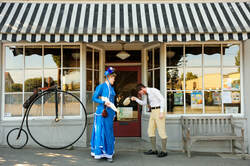
El día que Sarah cumplió 29 cumpleaños, su novio, Gabriel Chrisman, le regaló un corsé. Ella lo miró horrorizada. Amaba la época victoriana, pero detestaba esos corpiños porque había oído que eran incómodos, no dejaban respirar e incluso rompían costillas a las mujeres que los usaban. Gabriel insistió y Sarah acabó probándoselo. Unos días después, las costillas de la estadounidense permanecían intactas y los pulmones seguían funcionando con normalidad.
Eso ocurrió en 2009. En 2010, después de un año usando corsé, Sarah decidió hacerse vestidos, camisas y faldas como las que llevaban las mujeres en el Estados Unidos de 1880. «Siempre me había intrigado ese periodo y me encantaba su belleza, pero había escuchado muchos estereotipos negativos de esa época y nunca me planteé cuestionarlos», indica. «Al descubrir que, a diferencia de lo que decían, el corsé no era un objeto represor, sino una prenda que empodera, me pregunté qué más relatos de ese tiempo serían falsos».
Las migrañas se hicieron más leves desde que comenzó a llevar corsé. Su cintura se ha reducido de tamaño y su espalda está más erguida desde que lo usa a diario. «Me puso más en contacto con mi propio cuerpo y me hizo ver lo que necesitaba: cuánto debía comer, lo bien que sentaba a mi espalda permanecer en posición erguida», explica. «Lo primero que nos enseñó esta ropa fue la importancia de la postura. La psicología de las personas no ha cambiado en los últimos 130 años, pero hemos modificado la forma en la que usamos nuestro cuerpo y esto ha tenido un gran impacto en la postura. Actividades como conducir vehículos o ver televisión han provocado que los individuos se desplomen y echen sus hombros hacia delante. En el siglo XIX, les enseñaban a permanecer derechos y echar los hombros hacia atrás, desde que eran niños».
Aquel descubrimiento avivó aún más su curiosidad por aquella época. Sarah y Gabriel eran historiadores. Hasta entonces habían leído todo lo que caía en sus manos sobre la era de la revolución industrial, pero a partir de ese momento decidieron que el mejor método para investigar ese periodo sería viviendo como lo hicieron los anglosajones de 1880 y 1890. «Antes de conocernos, Gabriel y yo apreciabamos el valor de mirar el mundo desde los ojos de otras eras. Por eso no ha sido difícil emprender este proyecto. De hecho, para mi marido, es algo habitual. De pequeño, no fue a un colegio convencional. Estudió mediante el método de escuela en casa y eso hizo que nunca viese la barrera que parece existir hoy entre la vida diaria y el sistema educativo».
El mundo victoriano fue surgiendo poco a poco alrededor de la pareja. «No es algo que ocurra de repente. Eso solo pasa en los cuentos de hadas y las películas de Hollywood. Nosotros tuvimos que esforzarnos mucho por alcanzar nuestro sueño», relata. Reconstruir el pasado implica muchos regalos de cumpleaños, muchas búsquedas en anticuarios y muchas indagaciones en archivos.
La pareja compró una casa en Port Townsend, una pequeña ciudad donde todavía quedan varios edificios de ese tiempo y que, desde 1976, forma parte del Registro nacional de lugares históricos de EEUU. En este puerto victoriano del estado de Washington encontraron una vivienda que seguía tal y como la edificó Henry Lake en 1888. Aquel tipo se dedicaba a construir casas. Las habitaba el tiempo justo para obtener la licencia de habitabilidad y así se libraba de los impuestos que debía pagar si hubiera declarado que estaban destinadas a la venta. Al poco, volvía a levantar una nueva vivienda y repetía el proceso. Era una década de esplendor económico y entonces, como siempre, muchos se dedicaban a especular.
La ropa victoriana que ella misma se cosía a mano enseñó mucho a Sarah. La historiadora descubrió mediante el tacto y el roce de las telas cómo se sentían aquellas mujeres hace algo más de un siglo. «Me acostumbré tanto a la presencia y los movimientos de mi falda que empecé a sentir que me informaba de la proximidad de los objetos a mi alrededor y esas brisas de aire apenas perceptibles que se producen cuando una persona o un animal pasa a tu lado», detalla. «Nunca tuve que analizar estas señales y muy pronto dejé de pensar en ellas. En poco tiempo se habían convertido en un sentido periférico. Gabriel decía que yo, al vestir ropa victoriana, había hecho florecer mi verdadera identidad».
El historiador dejó sus gafas del siglo XXI y las cambió por unas lentes verdes fabricadas en 1850, unos anteojos de montura dorada y unas gafas de pinza para leer. «Cada vez que se nos rompía un objeto actual, lo reemplazábamos por el que se usaba en la época victoriana», comenta Sarah. «Después de ver todo lo que la vestimenta nos había enseñado, nos dimos cuenta de todo lo que podíamos aprender del resto de artículos de la vida cotidiana».
El estudio de la historia desde las sensaciones aportaba datos que la investigación académica no llega siquiera a insinuar. En su viaje al pasado tecnológico no había sitio para teléfonos móviles ni televisión. Tampoco para electrodomésticos de hoy. Al entrar en su casa nueva, en Port Townsend, encontraron un frigorífico eléctrico en la cocina. Lo vendieron y, en su lugar, desde entonces, utilizan una heladera con placas de hielo.
Todas las mañanas, cuando se levantan, dan cuerda a su reloj mecánico. Sarah hizo el colchón en el que duermen. Cosió la tela y la rellenó de plumas. En invierno, cuando hace frío, introducen bolsas de agua entre las sábanas para obtener calor. En las habitaciones usan estufas de gas y queroseno, como hacían los habitantes de esa casa cien años atrás.
Tampoco usan bombillas eléctricas. Los inventos de Nikola Tesla que expandieron la electricidad por el mundo a principios del XX les parecen endriagos de un futuro distópico. Tan solo cuando hay visita en casa, y como rigurosa excepción, utilizan las primeras bombillas que patentaron Tesla y Edison. «Nos quedamos muy sorprendidos cuando vimos que las lámparas de gasolina antiguas daban mucha más luz que las reproducciones actuales», revela. «Estas tecnologías nos mantienen más en contacto con la naturaleza. Nos hacen ser más conscientes de las diferentes estaciones, de los días largos de verano y los cortos de invierno. También prestamos más atención a nuestros alimentos en función del momento del año. Nos encanta utilizar tecnologías que podemos entender y podemos reparar, como las lámparas de gasolina o las bicicletas. Esto nos produce la sensación de tener más control de nuestras vidas. En cambio, muchos aparatos modernos son cajas mágicas. Aprietas un botón y ocurre algo sin que tengas la más mínima idea de cómo funciona».
Hornean su pan. El cepillo del pelo tiene más de 130 años y el jabón del baño es de una compañía que nació en 1839. En la bañera, se echan agua caliente con una vasija. Sarah limpia la alfombra con una escoba mojada en agua y sal. Friega los cristales con vinagre y lava la ropa con Ivory Soap, un jabón que la compañía Procter and Gamble empezó a vender en 1879.
La historiadora no tiene carné de conducir. Para desplazarse, usa una réplica de un triciclo de rueda alta construido en 1880. Gabriel fabrica, repara y vende bicicletas. Ese es su oficio, además de historiador. Ella, para ganarse la vida, escribe libros y juntos hacen presentaciones de la época en la que viven a pesar de que el resto de personas a su alrededor actúen como si fuese 2015. Hace dos años publicó Victorian Secrets: What a Corset Taught Me about the Past, the Present, and Myself (Secretos victorianos: Lo que el corsé me enseñó sobre el pasado, el presente y sobre mí) y este año ha presentado This Victorian Life: Modern Adventures in Nineteenth-Century Culture, Cooking, Fashion, and Technology (Esta vida victoriana: Aventuras modernas en la cultura del siglo XIX, cocina, moda y tecnología). «Ninguno de los dos ganamos mucho dinero. Tenemos que vigilar bien los gastos. Pero queremos mostrar que todas las personas podemos hacer realidad nuestros sueños si nos esforzamos por conseguirlos y tomamos las decisiones correctas».
Este viaje al pasado está lleno de libros de final del XIX. Los dos investigadores decidieron adentrarse en los tiempos victorianos desde las voces de su gente. Buscan libros, publicaciones y periódicos en anticuarios, bibliotecas, archivos universitarios y sociedades históricas. Desconfían de lo que cuentan los libros académicos y divulgativos de esa etapa. Dicen que ocurre lo mismo que en el juego del teléfono escacharrado. La realidad, al pasar por tantas bocas, acaba convertida en una caricatura despreciable. «Encontramos muchos libros y artículos digitalizados en AbeBooks.com y en la herramienta de búsqueda avanzada de Google Books».
–¿Internet? ¿Utilizáis internet? –pregunto en una entrevista por correo electrónico.
–Tenemos una web educativa para animar a otras personas a aprender más sobre la historia. Intenté dar folletos impresos porque es un método más victoriano, pero lo único que conseguí es que me gritaran. A la gente moderna no le gusta leer cuadernillos. Prefieren internet. Así que opté por utilizarlo para difundir nuestro proyecto de enseñanza. Además, ningún editor moderno aceptaría jamás un manuscrito. Aunque escribo mi diario en papel y con una pluma antigua, tengo que pasarlos a ordenador y enviarlos a mis editores a través de la Red. Es un diablo necesario.
Esa es la única sombra que pesa sobre la vida victoriana de esta pareja. «Lo más duro es soportar las reacciones de muchas personas. Vivimos en un mundo que no tolera lo distinto», constata. «Los únicos que te aceptan y tratan de entenderte son tus amigos de verdad. Los más receptivos suelen ser los familiares y los extranjeros».
Aunque podría ser que la diferencia entre un victoriano y un individuo de hoy tenga más que ver con las apariencias que con sus intereses e inquietudes. «Las décadas de 1880 y 1890 fueron de un dinamismo increíble y muchos de los asuntos que surgieron entonces siguen siendo estando en nuestro día a día. Por ejemplo, en esos años nació el teléfono. La preocupación de la población era cómo utilizarlo de un modo sensato y seguir manteniendo su privacidad. Los medios de transporte evolucionaron muy deprisa. La bicicleta se puso de moda a final de la década de los 70. En las revistas, publicaban extensos debates sobre cuáles eran los mejores métodos de iluminación y calefacción en las casas, en función de criterios económicos, sociales y medioambientales».
Lo que sí aleja una era de otra, según Sarah A. Chrisman, es «el tremendo optimismo de aquel tiempo frente al cinismo que impera en la actualidad». La mujer que cada día se pone un corsé que eleva su pecho y la sitúa en la postura de la valentía asegura: «Nos encantaría poder traer parte de esta ilusión y hacer ver a todo el mundo que cada persona tiene el control de sus decisiones y sus actitudes en la vida».
Eso ocurrió en 2009. En 2010, después de un año usando corsé, Sarah decidió hacerse vestidos, camisas y faldas como las que llevaban las mujeres en el Estados Unidos de 1880. «Siempre me había intrigado ese periodo y me encantaba su belleza, pero había escuchado muchos estereotipos negativos de esa época y nunca me planteé cuestionarlos», indica. «Al descubrir que, a diferencia de lo que decían, el corsé no era un objeto represor, sino una prenda que empodera, me pregunté qué más relatos de ese tiempo serían falsos».
Las migrañas se hicieron más leves desde que comenzó a llevar corsé. Su cintura se ha reducido de tamaño y su espalda está más erguida desde que lo usa a diario. «Me puso más en contacto con mi propio cuerpo y me hizo ver lo que necesitaba: cuánto debía comer, lo bien que sentaba a mi espalda permanecer en posición erguida», explica. «Lo primero que nos enseñó esta ropa fue la importancia de la postura. La psicología de las personas no ha cambiado en los últimos 130 años, pero hemos modificado la forma en la que usamos nuestro cuerpo y esto ha tenido un gran impacto en la postura. Actividades como conducir vehículos o ver televisión han provocado que los individuos se desplomen y echen sus hombros hacia delante. En el siglo XIX, les enseñaban a permanecer derechos y echar los hombros hacia atrás, desde que eran niños».
Aquel descubrimiento avivó aún más su curiosidad por aquella época. Sarah y Gabriel eran historiadores. Hasta entonces habían leído todo lo que caía en sus manos sobre la era de la revolución industrial, pero a partir de ese momento decidieron que el mejor método para investigar ese periodo sería viviendo como lo hicieron los anglosajones de 1880 y 1890. «Antes de conocernos, Gabriel y yo apreciabamos el valor de mirar el mundo desde los ojos de otras eras. Por eso no ha sido difícil emprender este proyecto. De hecho, para mi marido, es algo habitual. De pequeño, no fue a un colegio convencional. Estudió mediante el método de escuela en casa y eso hizo que nunca viese la barrera que parece existir hoy entre la vida diaria y el sistema educativo».
El mundo victoriano fue surgiendo poco a poco alrededor de la pareja. «No es algo que ocurra de repente. Eso solo pasa en los cuentos de hadas y las películas de Hollywood. Nosotros tuvimos que esforzarnos mucho por alcanzar nuestro sueño», relata. Reconstruir el pasado implica muchos regalos de cumpleaños, muchas búsquedas en anticuarios y muchas indagaciones en archivos.
La pareja compró una casa en Port Townsend, una pequeña ciudad donde todavía quedan varios edificios de ese tiempo y que, desde 1976, forma parte del Registro nacional de lugares históricos de EEUU. En este puerto victoriano del estado de Washington encontraron una vivienda que seguía tal y como la edificó Henry Lake en 1888. Aquel tipo se dedicaba a construir casas. Las habitaba el tiempo justo para obtener la licencia de habitabilidad y así se libraba de los impuestos que debía pagar si hubiera declarado que estaban destinadas a la venta. Al poco, volvía a levantar una nueva vivienda y repetía el proceso. Era una década de esplendor económico y entonces, como siempre, muchos se dedicaban a especular.
La ropa victoriana que ella misma se cosía a mano enseñó mucho a Sarah. La historiadora descubrió mediante el tacto y el roce de las telas cómo se sentían aquellas mujeres hace algo más de un siglo. «Me acostumbré tanto a la presencia y los movimientos de mi falda que empecé a sentir que me informaba de la proximidad de los objetos a mi alrededor y esas brisas de aire apenas perceptibles que se producen cuando una persona o un animal pasa a tu lado», detalla. «Nunca tuve que analizar estas señales y muy pronto dejé de pensar en ellas. En poco tiempo se habían convertido en un sentido periférico. Gabriel decía que yo, al vestir ropa victoriana, había hecho florecer mi verdadera identidad».
El historiador dejó sus gafas del siglo XXI y las cambió por unas lentes verdes fabricadas en 1850, unos anteojos de montura dorada y unas gafas de pinza para leer. «Cada vez que se nos rompía un objeto actual, lo reemplazábamos por el que se usaba en la época victoriana», comenta Sarah. «Después de ver todo lo que la vestimenta nos había enseñado, nos dimos cuenta de todo lo que podíamos aprender del resto de artículos de la vida cotidiana».
El estudio de la historia desde las sensaciones aportaba datos que la investigación académica no llega siquiera a insinuar. En su viaje al pasado tecnológico no había sitio para teléfonos móviles ni televisión. Tampoco para electrodomésticos de hoy. Al entrar en su casa nueva, en Port Townsend, encontraron un frigorífico eléctrico en la cocina. Lo vendieron y, en su lugar, desde entonces, utilizan una heladera con placas de hielo.
Todas las mañanas, cuando se levantan, dan cuerda a su reloj mecánico. Sarah hizo el colchón en el que duermen. Cosió la tela y la rellenó de plumas. En invierno, cuando hace frío, introducen bolsas de agua entre las sábanas para obtener calor. En las habitaciones usan estufas de gas y queroseno, como hacían los habitantes de esa casa cien años atrás.
Tampoco usan bombillas eléctricas. Los inventos de Nikola Tesla que expandieron la electricidad por el mundo a principios del XX les parecen endriagos de un futuro distópico. Tan solo cuando hay visita en casa, y como rigurosa excepción, utilizan las primeras bombillas que patentaron Tesla y Edison. «Nos quedamos muy sorprendidos cuando vimos que las lámparas de gasolina antiguas daban mucha más luz que las reproducciones actuales», revela. «Estas tecnologías nos mantienen más en contacto con la naturaleza. Nos hacen ser más conscientes de las diferentes estaciones, de los días largos de verano y los cortos de invierno. También prestamos más atención a nuestros alimentos en función del momento del año. Nos encanta utilizar tecnologías que podemos entender y podemos reparar, como las lámparas de gasolina o las bicicletas. Esto nos produce la sensación de tener más control de nuestras vidas. En cambio, muchos aparatos modernos son cajas mágicas. Aprietas un botón y ocurre algo sin que tengas la más mínima idea de cómo funciona».
Hornean su pan. El cepillo del pelo tiene más de 130 años y el jabón del baño es de una compañía que nació en 1839. En la bañera, se echan agua caliente con una vasija. Sarah limpia la alfombra con una escoba mojada en agua y sal. Friega los cristales con vinagre y lava la ropa con Ivory Soap, un jabón que la compañía Procter and Gamble empezó a vender en 1879.
La historiadora no tiene carné de conducir. Para desplazarse, usa una réplica de un triciclo de rueda alta construido en 1880. Gabriel fabrica, repara y vende bicicletas. Ese es su oficio, además de historiador. Ella, para ganarse la vida, escribe libros y juntos hacen presentaciones de la época en la que viven a pesar de que el resto de personas a su alrededor actúen como si fuese 2015. Hace dos años publicó Victorian Secrets: What a Corset Taught Me about the Past, the Present, and Myself (Secretos victorianos: Lo que el corsé me enseñó sobre el pasado, el presente y sobre mí) y este año ha presentado This Victorian Life: Modern Adventures in Nineteenth-Century Culture, Cooking, Fashion, and Technology (Esta vida victoriana: Aventuras modernas en la cultura del siglo XIX, cocina, moda y tecnología). «Ninguno de los dos ganamos mucho dinero. Tenemos que vigilar bien los gastos. Pero queremos mostrar que todas las personas podemos hacer realidad nuestros sueños si nos esforzamos por conseguirlos y tomamos las decisiones correctas».
Este viaje al pasado está lleno de libros de final del XIX. Los dos investigadores decidieron adentrarse en los tiempos victorianos desde las voces de su gente. Buscan libros, publicaciones y periódicos en anticuarios, bibliotecas, archivos universitarios y sociedades históricas. Desconfían de lo que cuentan los libros académicos y divulgativos de esa etapa. Dicen que ocurre lo mismo que en el juego del teléfono escacharrado. La realidad, al pasar por tantas bocas, acaba convertida en una caricatura despreciable. «Encontramos muchos libros y artículos digitalizados en AbeBooks.com y en la herramienta de búsqueda avanzada de Google Books».
–¿Internet? ¿Utilizáis internet? –pregunto en una entrevista por correo electrónico.
–Tenemos una web educativa para animar a otras personas a aprender más sobre la historia. Intenté dar folletos impresos porque es un método más victoriano, pero lo único que conseguí es que me gritaran. A la gente moderna no le gusta leer cuadernillos. Prefieren internet. Así que opté por utilizarlo para difundir nuestro proyecto de enseñanza. Además, ningún editor moderno aceptaría jamás un manuscrito. Aunque escribo mi diario en papel y con una pluma antigua, tengo que pasarlos a ordenador y enviarlos a mis editores a través de la Red. Es un diablo necesario.
Esa es la única sombra que pesa sobre la vida victoriana de esta pareja. «Lo más duro es soportar las reacciones de muchas personas. Vivimos en un mundo que no tolera lo distinto», constata. «Los únicos que te aceptan y tratan de entenderte son tus amigos de verdad. Los más receptivos suelen ser los familiares y los extranjeros».
Aunque podría ser que la diferencia entre un victoriano y un individuo de hoy tenga más que ver con las apariencias que con sus intereses e inquietudes. «Las décadas de 1880 y 1890 fueron de un dinamismo increíble y muchos de los asuntos que surgieron entonces siguen siendo estando en nuestro día a día. Por ejemplo, en esos años nació el teléfono. La preocupación de la población era cómo utilizarlo de un modo sensato y seguir manteniendo su privacidad. Los medios de transporte evolucionaron muy deprisa. La bicicleta se puso de moda a final de la década de los 70. En las revistas, publicaban extensos debates sobre cuáles eran los mejores métodos de iluminación y calefacción en las casas, en función de criterios económicos, sociales y medioambientales».
Lo que sí aleja una era de otra, según Sarah A. Chrisman, es «el tremendo optimismo de aquel tiempo frente al cinismo que impera en la actualidad». La mujer que cada día se pone un corsé que eleva su pecho y la sitúa en la postura de la valentía asegura: «Nos encantaría poder traer parte de esta ilusión y hacer ver a todo el mundo que cada persona tiene el control de sus decisiones y sus actitudes en la vida».
***
Obekti (Bulgarian)
http://www.obekti.bg/chovek/10552-Да-живееш-в-18-век-жена-се-отказва-от-модерните-технологии-за-сметка-на-начин-на-живот-от-Викторианската-епоха
http://www.obekti.bg/chovek/10552-Да-живееш-в-18-век-жена-се-отказва-от-модерните-технологии-за-сметка-на-начин-на-живот-от-Викторианската-епоха
Да живееш в 18. век - жена се отказва от модерните технологии за сметка на начин на живот от Викторианската епоха
Докато някои хора се опитват да се сдобият с всяка една нова джаджа, която модерните технологии им поднасят, една жена се е запътила точно в обратната историческа посока, пише Express.
Сара Крисман е на 33 години и живее в американския град Сиатъл, но определено би се чувствала по-добре на друго място и с няколко века назад.
Вместо да се отдаде на модерната епоха, Сара прегръща с всички сили Викторианския начин на живот - от готвенето на начина си на обличане. Въпреки че още от дете си падала по истории и приказки от онова време, истинската промяна за Сара настъпва преди години, когато получава интересен подарък от съпруга си.
"Винаги съм обичала Викторианската епоха и когато мъжът ми подари корсет за 29-тия ми рожден ден, този аксесоар ми хареса изключително много", припомня си младата жена. Усещането, което изпитвала, носейки корсета, я накарало да започне постепенно да променя начина си на обличане. В момента Сара носи само дрехи, изработени по поръчка, и се опитва да не използва нито един уред, който не е съществувал във Викторианската епоха. Жената готви по рецепти от 18. и 19. век и дори е написала книга, посветена на Викторианския етикет.
Сара има пълната подкрепа на своя съпруг, който е магистър по библиотечно дело.
"И двамата обичаме историята, експериментираме и се забавляваме много. Той е много съпричастен", доволна е Сара, която се радва, че техните приятели също ги подкрепят.
"Освен това постоянното носене на корсета стопи талията ми с повече от десет сантиметра", шегува се тя. "Знаем, че няма как да се върнем в миналото, но нищо не ни пречи да опитваме".
И все пак един-единствен аспект на модерната епоха се оказва прекалено силно изкушение за увлечената по миналото жена - Сара има свой Facebook акаунт.
***
Korea Daily
http://www.koreadaily.com/news/read.asp?art_id=2645573#sthash.CO2Kcpqy.gbpl
시애틀에서 만난 19세기 빅토리아 여성
전기없이 자연광과 오일램프로 옛 방식대로 살아
한국의 풍경에서도 영감 얻어
(워싱턴주 포트타운센드에 살고 있는 세라 크리스만 여성은 매일 코르셋을 입고 전기와 전화를 쓰지 않는 등 모든 생활을 19세기 빅토리아 시대의 방식대로 살아가고 있다. 이 독특한 여성을 직접 만나봤다.)
- 자신을 소개한다면?
2002년 워싱턴 대학(UW)에서 국제연구학과 불어불문학을 전공했고 역사에 관심이 있었다. 2006년 일본에서 영어강사로 일했을 때 친구가 한국에서 영어강사로 일하고 있어 한국을 방문했다. 역사와 현대가 공존하는 서울풍경은 빅토리아 시대의 삶을 살아가게끔 하는 이유중 하나가 되었다.
- 왜 하필 19세기 후반의 삶의 방식을 추구하는가?
빅토리아 시대는 ‘혁신과 변화’의 시대라고 할 수 있다. 많은 것들을 새로 개발하여 사용하기 시작했고 현대로 넘어가는 과도기에 있는 시대라고 할 수 있다. 전화를 처음 사용하고 전화기에 의존하기 시작했던 시기이다. 1880년대의 기사 중 전화기를 너무 자주 사용한다는 불평이 있었는데 얼마 전 찻집에서 비슷한 불평을 하는 대화를 듣고 같은 문제가 200년 넘게 이어지고 있다는 생각이 들었다.
- 어떻게 필요한 물품을 구하나?
옷가지와 간단한 물품들은 직접 옛날 책을 보고 공부해서 만든다. 다른 물품들은 차고세일이나 앤틱상점에서 구입한다. 음식은 19세기의 요리책을 참고하지만 많은 것들이 변했기에 사용량을 조금씩 조절한다. 현재의 닭은 예전보다 훨씬 크기 때문에 요리책에 달걀 2알이라면 1알을 사용한다.
-하루의 일과는?
자연 빛을 최대한 활용하기 위해 해가 뜰 때 일어나서 그릇과 주전자로 목욕을 한다. 빵을 구워 아침을 먹고 남편은 자전거를 타고 출근한다. 나도 자전거를 사용하고 주로 집에서 집필을 하거나 필요한 물품들을 만든다. 여름에는 해가 질 때쯤 잠자리에 들고 겨울에는 오일램프를 사용해 저녁시간을 보낸다.
- 현대와 빅토리아 시대의 삶의 방식 중에 가장 다른 점은 ?
예전에는 자신이 가진 것에 감사하고 항상 좋은 점을 보려고 노력하는 긍정적인 삶을 살았던 반면 현재는 부정적이고 나쁜 면에 치중한다고 생각한다. 옛 사람들은 서로에 대한 긍정적인 믿음과 ‘선’에 대한 확신이 있었던 반면 현재는 그러한 점이 많이 줄었다고 본다.
- Estar Choi(최효경, Mary 스튜디오 대표 )와는 어떤 인연인가 ?
1년전 제퍼슨 카운티 도서관에서 자원봉사자로 영어를 가르쳤을 때 만났다. 전문 사진 작가여서 내 사진을 많이 찍어주는 좋은 친구이다.
-어떠한 내용의 책을 주로 쓰는지?
19세기 옷가지로부터 글로는 전해져 내려오지 않는 부분들에 관한 글을 쓴다. 옷은 그것을 입는 사람을 대변한다고 생각한다.
(본보에서 만난 최효경(오른쪽)씨와 세라 크리스만) (이수경 인턴기자 [email protected])
이수경 인턴기자
시애틀에서 만난 19세기 빅토리아 여성
전기없이 자연광과 오일램프로 옛 방식대로 살아
한국의 풍경에서도 영감 얻어
(워싱턴주 포트타운센드에 살고 있는 세라 크리스만 여성은 매일 코르셋을 입고 전기와 전화를 쓰지 않는 등 모든 생활을 19세기 빅토리아 시대의 방식대로 살아가고 있다. 이 독특한 여성을 직접 만나봤다.)
- 자신을 소개한다면?
2002년 워싱턴 대학(UW)에서 국제연구학과 불어불문학을 전공했고 역사에 관심이 있었다. 2006년 일본에서 영어강사로 일했을 때 친구가 한국에서 영어강사로 일하고 있어 한국을 방문했다. 역사와 현대가 공존하는 서울풍경은 빅토리아 시대의 삶을 살아가게끔 하는 이유중 하나가 되었다.
- 왜 하필 19세기 후반의 삶의 방식을 추구하는가?
빅토리아 시대는 ‘혁신과 변화’의 시대라고 할 수 있다. 많은 것들을 새로 개발하여 사용하기 시작했고 현대로 넘어가는 과도기에 있는 시대라고 할 수 있다. 전화를 처음 사용하고 전화기에 의존하기 시작했던 시기이다. 1880년대의 기사 중 전화기를 너무 자주 사용한다는 불평이 있었는데 얼마 전 찻집에서 비슷한 불평을 하는 대화를 듣고 같은 문제가 200년 넘게 이어지고 있다는 생각이 들었다.
- 어떻게 필요한 물품을 구하나?
옷가지와 간단한 물품들은 직접 옛날 책을 보고 공부해서 만든다. 다른 물품들은 차고세일이나 앤틱상점에서 구입한다. 음식은 19세기의 요리책을 참고하지만 많은 것들이 변했기에 사용량을 조금씩 조절한다. 현재의 닭은 예전보다 훨씬 크기 때문에 요리책에 달걀 2알이라면 1알을 사용한다.
-하루의 일과는?
자연 빛을 최대한 활용하기 위해 해가 뜰 때 일어나서 그릇과 주전자로 목욕을 한다. 빵을 구워 아침을 먹고 남편은 자전거를 타고 출근한다. 나도 자전거를 사용하고 주로 집에서 집필을 하거나 필요한 물품들을 만든다. 여름에는 해가 질 때쯤 잠자리에 들고 겨울에는 오일램프를 사용해 저녁시간을 보낸다.
- 현대와 빅토리아 시대의 삶의 방식 중에 가장 다른 점은 ?
예전에는 자신이 가진 것에 감사하고 항상 좋은 점을 보려고 노력하는 긍정적인 삶을 살았던 반면 현재는 부정적이고 나쁜 면에 치중한다고 생각한다. 옛 사람들은 서로에 대한 긍정적인 믿음과 ‘선’에 대한 확신이 있었던 반면 현재는 그러한 점이 많이 줄었다고 본다.
- Estar Choi(최효경, Mary 스튜디오 대표 )와는 어떤 인연인가 ?
1년전 제퍼슨 카운티 도서관에서 자원봉사자로 영어를 가르쳤을 때 만났다. 전문 사진 작가여서 내 사진을 많이 찍어주는 좋은 친구이다.
-어떠한 내용의 책을 주로 쓰는지?
19세기 옷가지로부터 글로는 전해져 내려오지 않는 부분들에 관한 글을 쓴다. 옷은 그것을 입는 사람을 대변한다고 생각한다.
(본보에서 만난 최효경(오른쪽)씨와 세라 크리스만) (이수경 인턴기자 [email protected])
이수경 인턴기자
***
Chinese
https://www.jiemian.com/article/556736.html
http://news.cri.cn/2015-9-14/f052c8a4-5095-9539-caa9-73abad3bb12c.html
http://sn.people.com.cn/n/2015/0914/c190205-26371011.html
http://news.163.com/api/15/0914/08/B3F7V3R6000155K8.html
http://www.qdaily.com/cooperation/articles/toutiao/15050.html?tt_group_id=6195353199061057793
http://blog.sina.com.cn/s/blog_c08cc5a00102w79z.html
http://hengyang.aixifan.com/a/ac2202733
https://www.zhihu.com/question/48497414/answer/451704230
http://city365.ca/#/new_info?post_id=247799
http://cn.ccyp.com/ccypContents?content_id=119782
http://www.twoeggz.com/news/2718015.html
http://www.qwbus.com/2015090011330.html
http://www.mingpaocanada.com/tor/htm/News/20160818/tdi1_r.htm
据英国《每日邮报》9月12日报道,美国西雅图一对年轻夫妻非常痴迷维多利亚文化,二人婚后坚持维多利亚时期“毫无现代化”的生活方式已有五年之久。 据报道,这个“复古家庭”中的男主人名为Gabriel Chrisman,女主人叫Sarah Chrisman。二人于2002年喜结连理,为了无限接近维多利亚时期的生活,他们买下了一幢1988年的老房子后,拆除了家中所有的现代化设施。按照维多利亚时期改造后的家中没有电没有网,没有任何现代化设施包括冰箱、烤箱和洗衣机。此外,夫妻俩的交通工具也别具一格:维多利亚时期的自行车,洗衣机被一个大水桶代替,完全手洗。 值得一提的是,夫妻两人的日常着装也是彻头彻尾的维多利亚风格,Gabriel一副绅士打扮:长筒袜配上金丝边眼镜;Sarah每天都穿着维多利亚时期的长裙,戴着束腰和帽子。Sarah表示,自己坚持了一年每天戴束腰的生活,即便是出门去爬山也没摘下来过,自己的腰围也从32寸瘦到了22寸。Sarah还专门为束腰写了一本书。 总之,这对“复古夫妻”的衣食住行甚至是娱乐方式都是维多利亚时期的风格,他们坚定认为19世纪的生活方式比现代忙碌的生活更健康。同时表示,虽然自己周围的朋友都过着现代化生活,但是他们也还保留着与其正常的社交活动,并未与世隔绝。
***
Thai
https://th.tuffgirlsmagazine.com/this-woman-wears-sleeps
แฟชั่นของผู้หญิงได้ก่อให้เกิดการถกเถียงกันอย่างถี่ถ้วนในทุกแง่มุมและการเปลี่ยนแนวโน้ม แต่บทความเกี่ยวกับเสื้อผ้าไม่ได้มีการฉลองและประหัตประหารอย่างเช่นเครื่องรัดตัวแบบดั้งเดิม วันนี้ความคิดเห็นที่นิยมคิดออกแบบลูกไม้เป็นข้อ จำกัด ทั้งตัวอักษรและเปรียบเทียบกับการออกแบบที่เข้มงวดมาเพื่อเป็นสัญลักษณ์ของการปราบปรามทางสังคมของผู้หญิงอเมริกันยุค 18 ถึงศตวรรษที่ 19 คนอื่น ๆ มี fetishized เสื้อผ้าเป็นสุดยอดในการสึกหรอสวมใส่ ไม่ใช่เรื่องแปลกที่จะเห็นซาตินและเบดที่ขายพร้อมกับน้ำมันนวดและตุ๊กตาหมู (ฉันไม่ได้พูดถึง Paddington Bear) ที่ร้านชุดชั้นในสำหรับผู้ใหญ่ ดังนั้นเมื่อ "ความลับของวิคตอเรีย: สิ่งที่ฉันได้เรียนรู้เกี่ยวกับอดีตปัจจุบันและตัวฉัน" (Skyhorse Publishing: November 2013) ลงบนโต๊ะของฉันฉันรู้สึกทึ่งกับข้อกล่าวหาของนักเขียนว่าการใส่เครื่องรัดตัวเป็นแบบบวก, รัก - ถ้าไม่ใช่ สตรีนิยม - ย้ายในส่วนของเธอ
เพิ่มเติม: เพิ่มความมั่นใจในร่างกายของคุณ ในตอนต้นผู้เขียน Sarah Chrisman ไม่น่าสงสัยเหมือนกับคนอื่น ๆ เกี่ยวกับเครื่องรัดตัว หลังจากได้รับของขวัญจากสามีที่มีเจตนาดีของเธอเป็นของขวัญแล้วเธอจึงละเลยไม่เต็มใจที่จะสวมใส่สิ่งที่เธอคิดว่าเป็นเสื้อผ้าที่น่าอึดอัดและอาจจะล้มเลิกแม้กระทั่งความสุภาพเพียงเล็กน้อยและตกใจเมื่อเธอสนุกกับมัน เธอสูญเสียสองขนาดในเอวทันทีเมื่อการปักขึ้น แต่นาฬิกาทรายที่น่าสนใจใช้รูปแบบที่ตัวเองของเธออธิบายเต็มรูป 30- บางสิ่งบางอย่างบอกว่าเธอทันทีรู้สึกมากขึ้นเร้าใจและโดดเด่นในเครื่องรัดตัวกว่าที่เธอเคยมีในเสื้อผ้าร่วมสมัยเพราะในคำพูดของเธอ "ฉันไม่พอดีเหมือนเด็กชายอายุ 12 ปี." ในขณะที่เราเดินทางไปกับ ผู้เขียนเกี่ยวกับการผจญภัยของเธอด้วยเสื้อผ้าแบบวิคตอเรียที่ได้รับการค้นคว้าเป็นอย่างดี Chrisman กล่าวถึงสิ่งที่เธอกล่าวว่าเป็นตำนานเรื่องความปลอดภัยโดยรอบการ corsetry จากการเดินทางเช่นซี่โครงที่ขาดและอวัยวะที่ถูกขยับขยายที่เธออ้างว่าไม่มีพื้นฐานทางวิทยาศาสตร์ เธอยังอธิบายว่าทำไมเอวเป็นส่วนหนึ่งของร่างกายมนุษย์ที่สามารถทำได้ง่ายและปลอดภัย (ลองสวมรัดตัวบนต้นขาของคุณไม่ว่าจะเช็ดถักอย่างใดอย่างหนึ่งไม่มีอะไรให้เศร้า)…
***
"Waisted Curves" Book Review by Lucy's Corsetry
***
In a seaport town in the late 19th-century Pacific Northwest, a group of friends find themselves drawn together —by chance, by love, and by the marvelous changes their world is undergoing. In the process, they learn that the family we choose can be just as important as the ones we're born into. Join their adventures in
The Tales of Chetzemoka
Buy the book
|
First Wheel in Town:
|
Buy the book
|
Love Will Find A Wheel:
|
Buy the book
|
A Rapping At The Door:
|
Buy the book
|
Delivery Delayed:
|
Buy the Book
|
A Trip and a Tumble:
|
***
Victorian Secrets:
|
|
For words of wit and advice sage,
I hope you'll like my author page!
History lessons, folks who dare,
Please do share it while you're there!
https://www.facebook.com/ThisVictorianLife
Thank you!
Search this website:
***

